Paul van Yperen's Blog, page 7
July 31, 2025
Pierre Larquey
Pierre Larquey (1884-1962) was one of the great supporting actors of French cinema from the 1930s to the 1950s. He appeared in 233 films and 11 television films.
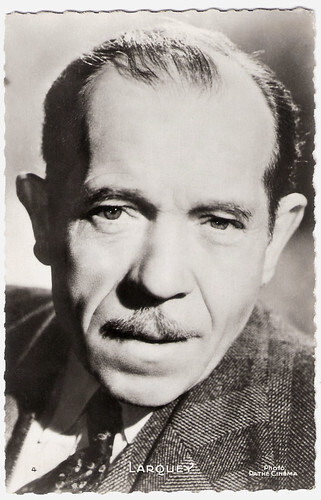
French postcard by Editions P.I., Paris, no. 4. Photo: Pathé Cinema.
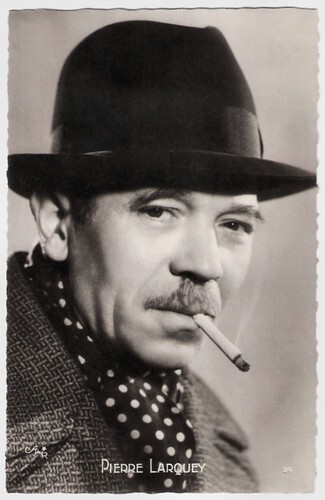
French postcard by Editions O.P., Paris, no. 24.
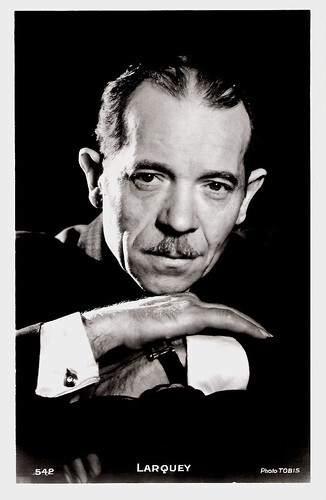
French postcard by Editions Chantal, Paris, no. 542. Photo: Tobis.
Variety and Parisian cabarets
Pierre Raphael Larquey was born in 1884 in Cénac, a small town in the Gironde, near Bordeaux in south-west France. He was the son of a cart driver.
Pierre was reluctant to enter the seminary before enlisting in the colonial infantry. He served for five years, notably from 1905 to 1907 in Madagascar, and returned to civilian life as a corporal. On his return to France, he tried his luck in the theatre.
He graduated from the Bordeaux Conservatoire with a first prize in acting. He moved to Paris and joined the Théâtre des Variétés, where he stayed for fifteen years. He also appeared in some early silent films, like Le Nabab (Albert Capellani, 1911), Germinal (Albert Capellani, 1913), and Patrie (Albert Capellani, 1914).
During the First World War, he was called up as a corporal. Then, he served as a sergeant and finally as a sergeant-major at the Front from 1915 to 1918. In 1919, he returned to the variety theatre, but also worked in several Parisian cabarets.
Pierre Larquey started his film career really with the advent of sound film. He was 47 when he had a small part in the drama Sola / Alone (Henri Diamant-Berger, 1931) with the singer Damia . More than two hundred films followed.
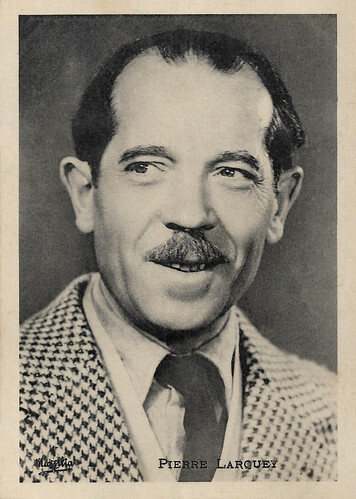
French collector card by Massilia.
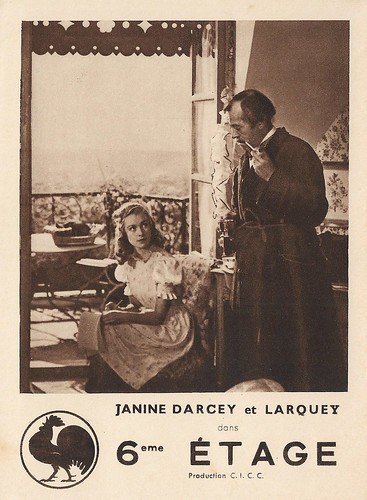
French mini-poster (collector card) by Pathé. Photo: CICC / Pathé. Janine Darcey and Pierre Larquey in Sixième Étage / Sixth Floor (Maurice Cloche, 1941).
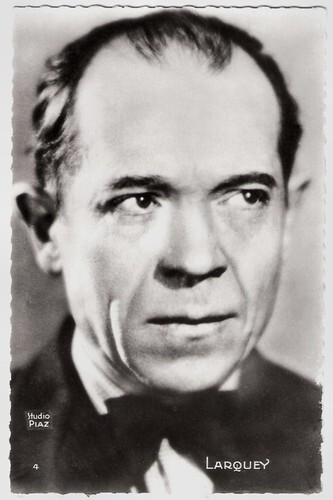
French postcard by Editions P.I., no. 4. Photo: Studio Piaz.
Directed by Pagnol, Feyder and Clouzot
In his memoirs, Marcel Pagnol recounted that Pierre Larquey, then a toy dealer, was hired in 1928 to play a very small role in the original stage version of 'Topaze'. His talent and the defection of an actor led Pagnol and André Lefaur to give him the more important role of Tamise. Larquey would play Tamise again in the 1933 film version directed by Louis Gasnier and starring Louis Jouvet . In 1951, he also played Tamise in the second film version directed by Marcel Pagnol with Fernandel.
He was directed by Jean Renoir in Madame Bovary (1934), by Jacques Feyder in Le Grand Jeu (1934) and by Abel Gance in Poliche (1935). Marcel L'Herbier directed him in Le Scandale / The Scandal (1934) starring Gaby Morlay , La Citadelle du silence / The Citadel of Silence (1937) with Annabella , and Adrienne Lecouvreur (1938) starring Yvonne Printemps .
Among his best-known roles are also those of Monsieur Colin in the comedy thriller L'assassin habite au 21 / The Murderer Lives at Number 21 (1942) and Docteur Michel Vorzet in Le Corbeau / The Raven (1943), both directed by Henri-Georges Clouzot. In Le Corbeau, he played one of his few more sinister and mysterious characters.
During two years of the German occupation of France, 1942 and 1943, the actor did a regular Thursday morning youth radio program in which he would talk about the country's culture, such as its museums and the glories of the Napoleonic era. After the war, he starred opposite Odette Joyeux and François Périer in the fantasy Sylvie et le fantôme / Sylvie and the Ghost (Claude Autant-Lara, 1946) and the police drama Quai des Orfèvres / Goldsmiths' Quay (Henri-Georges Clouzot, 1947) starring Suzy Delair , Bernard Blier and Louis Jouvet .
In 1954, he was the voice of the lamplighter (‘La consigne, c'est la consigneuh...’) on the Little Prince album with Gérard Philipe and Georges Poujouly. The following year, he had a small role in the classic thriller Les Diaboliques / Diabolique (Henri-Georges Clouzot, 1955), starring Simone Signoret . He also appeared with Signoret in the historical drama Les Sorcières de Salem / The Crucible (Raymond Rouleau, 1957) with a screenplay adapted by Jean-Paul Sartre from the 1953 play 'The Crucible', by Arthur Miller. In 1960, he appeared in Henri Verneuil's Le Président with Jean Gabin . Pierre Larquey died of a heart attack in 1962 and was buried in Maisons-Laffitte. He was 77.
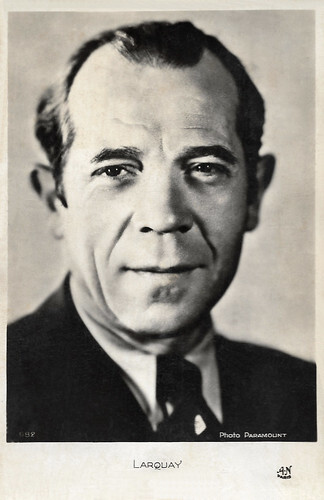
French postcard by A.N., Paris, no. 982. Photo: Paramount.
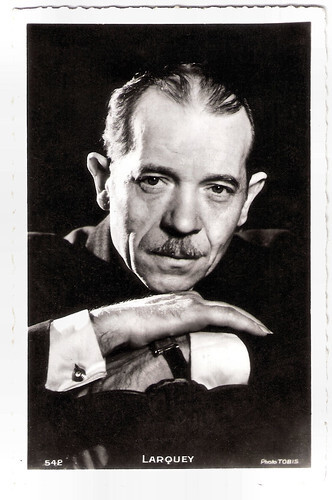
French postcard by Editions Chantal, Paris, no. 542. Photo: Tobis.
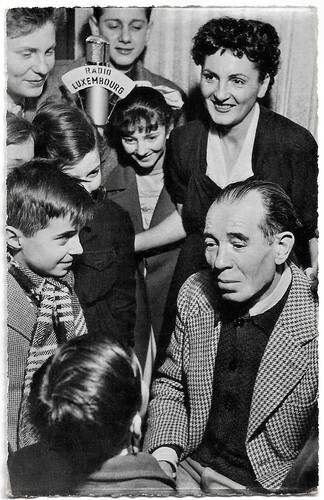
French postcard by Imp. I.D.E.A.C., Paris. Photo: Radio-Luxembourg. Caption: Grandpapa Larquey to thousands of grandchildren on Radio-Luxembourg.
Sources: James Travers (French Films), Caroline Hanotte (CinéArtistes - French), Wikipedia (French and English) and .

French postcard by Editions P.I., Paris, no. 4. Photo: Pathé Cinema.

French postcard by Editions O.P., Paris, no. 24.

French postcard by Editions Chantal, Paris, no. 542. Photo: Tobis.
Variety and Parisian cabarets
Pierre Raphael Larquey was born in 1884 in Cénac, a small town in the Gironde, near Bordeaux in south-west France. He was the son of a cart driver.
Pierre was reluctant to enter the seminary before enlisting in the colonial infantry. He served for five years, notably from 1905 to 1907 in Madagascar, and returned to civilian life as a corporal. On his return to France, he tried his luck in the theatre.
He graduated from the Bordeaux Conservatoire with a first prize in acting. He moved to Paris and joined the Théâtre des Variétés, where he stayed for fifteen years. He also appeared in some early silent films, like Le Nabab (Albert Capellani, 1911), Germinal (Albert Capellani, 1913), and Patrie (Albert Capellani, 1914).
During the First World War, he was called up as a corporal. Then, he served as a sergeant and finally as a sergeant-major at the Front from 1915 to 1918. In 1919, he returned to the variety theatre, but also worked in several Parisian cabarets.
Pierre Larquey started his film career really with the advent of sound film. He was 47 when he had a small part in the drama Sola / Alone (Henri Diamant-Berger, 1931) with the singer Damia . More than two hundred films followed.

French collector card by Massilia.

French mini-poster (collector card) by Pathé. Photo: CICC / Pathé. Janine Darcey and Pierre Larquey in Sixième Étage / Sixth Floor (Maurice Cloche, 1941).

French postcard by Editions P.I., no. 4. Photo: Studio Piaz.
Directed by Pagnol, Feyder and Clouzot
In his memoirs, Marcel Pagnol recounted that Pierre Larquey, then a toy dealer, was hired in 1928 to play a very small role in the original stage version of 'Topaze'. His talent and the defection of an actor led Pagnol and André Lefaur to give him the more important role of Tamise. Larquey would play Tamise again in the 1933 film version directed by Louis Gasnier and starring Louis Jouvet . In 1951, he also played Tamise in the second film version directed by Marcel Pagnol with Fernandel.
He was directed by Jean Renoir in Madame Bovary (1934), by Jacques Feyder in Le Grand Jeu (1934) and by Abel Gance in Poliche (1935). Marcel L'Herbier directed him in Le Scandale / The Scandal (1934) starring Gaby Morlay , La Citadelle du silence / The Citadel of Silence (1937) with Annabella , and Adrienne Lecouvreur (1938) starring Yvonne Printemps .
Among his best-known roles are also those of Monsieur Colin in the comedy thriller L'assassin habite au 21 / The Murderer Lives at Number 21 (1942) and Docteur Michel Vorzet in Le Corbeau / The Raven (1943), both directed by Henri-Georges Clouzot. In Le Corbeau, he played one of his few more sinister and mysterious characters.
During two years of the German occupation of France, 1942 and 1943, the actor did a regular Thursday morning youth radio program in which he would talk about the country's culture, such as its museums and the glories of the Napoleonic era. After the war, he starred opposite Odette Joyeux and François Périer in the fantasy Sylvie et le fantôme / Sylvie and the Ghost (Claude Autant-Lara, 1946) and the police drama Quai des Orfèvres / Goldsmiths' Quay (Henri-Georges Clouzot, 1947) starring Suzy Delair , Bernard Blier and Louis Jouvet .
In 1954, he was the voice of the lamplighter (‘La consigne, c'est la consigneuh...’) on the Little Prince album with Gérard Philipe and Georges Poujouly. The following year, he had a small role in the classic thriller Les Diaboliques / Diabolique (Henri-Georges Clouzot, 1955), starring Simone Signoret . He also appeared with Signoret in the historical drama Les Sorcières de Salem / The Crucible (Raymond Rouleau, 1957) with a screenplay adapted by Jean-Paul Sartre from the 1953 play 'The Crucible', by Arthur Miller. In 1960, he appeared in Henri Verneuil's Le Président with Jean Gabin . Pierre Larquey died of a heart attack in 1962 and was buried in Maisons-Laffitte. He was 77.

French postcard by A.N., Paris, no. 982. Photo: Paramount.

French postcard by Editions Chantal, Paris, no. 542. Photo: Tobis.

French postcard by Imp. I.D.E.A.C., Paris. Photo: Radio-Luxembourg. Caption: Grandpapa Larquey to thousands of grandchildren on Radio-Luxembourg.
Sources: James Travers (French Films), Caroline Hanotte (CinéArtistes - French), Wikipedia (French and English) and .
Published on July 31, 2025 22:00
July 30, 2025
La Collectionneuse: Anita Louise
Anita Louise’s ethereal beauty opened the doors of Hollywood ever since childhood. She was so lovely that she was considered worthy of playing the divine Greta Garbo as a child in A Woman of Affairs (1928). When she grew up, she became one of the prettiest blondes who ever graced the screen in the 1930s. It sometimes worked to her disadvantage as, in the whole, producers seem to have been reluctant to give her meaty roles and preferred to use her for her decorative value. However, audiences apparently didn't complain about gazing at her delicate looks in countless movies.
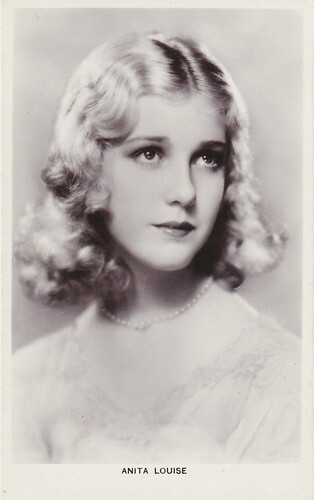
British postcard in the Picturegoer Series, London, no. 512.
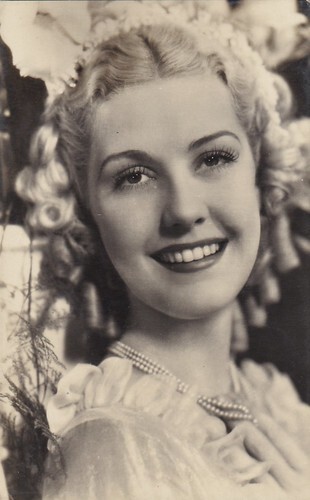
Spanish postcard by J.D.P., Valencia, no. 2157.
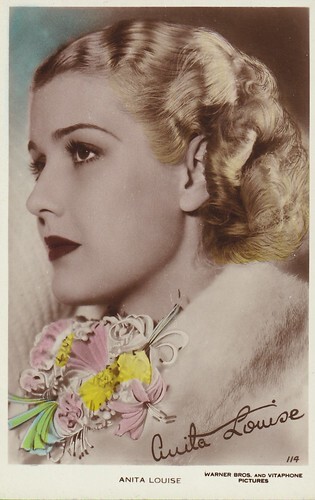
British postcard by Art Photo, no. 114. Photo: Warner Bros. and Vitaphone Pictures.
A child actress growing up
Anita Louise was born Anita Louise Fremault on the 9th of January 1915 in New York City, U.S.A.
Her first movie was Down to the Sea in Ships (1922), in an uncredited bit. As Anita Fremault, she appeared in child roles from 1924 on.
In 1929, she billed herself by her first and second names only and thus became 'Anita Louise'.
Tiffany Studios gave her her first leading roles in Just Like Heaven (1930) and The Third Alarm (1930).
In 1931, she was named one of the WAMPAS Baby Stars. That same year, she notably played Robert Woolsey’s foster daughter in Everybody’s Susie (1931) and was Lew Ayres’s leading lady in Heaven on Earth (1931).
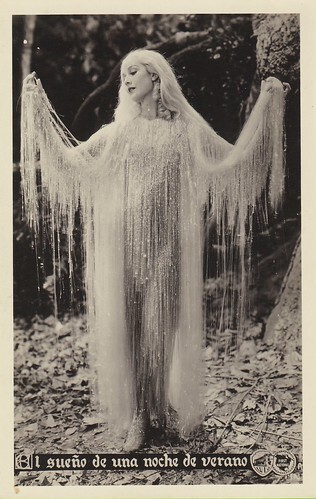
Spanish promotional postcard for A Midsummer Night’s Dream (Max Reinhardt, William Dieterle, 1935), based on the play by William Shakespeare. Photo: Warner Bros / First National. Caption: Al sueno de una noche verano is Spanish for A Midsummer Night’s Dream.
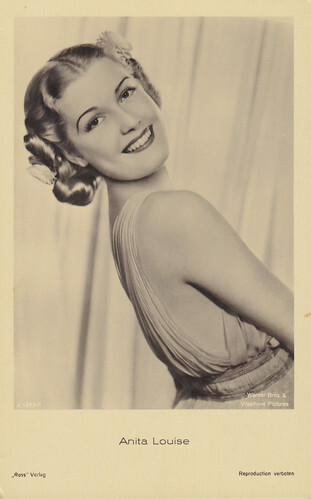
German postcard by Ross Verlag, no. A 1673/1, 1937-1938. Photo: Warner Bros / Vitaphone Pictures.
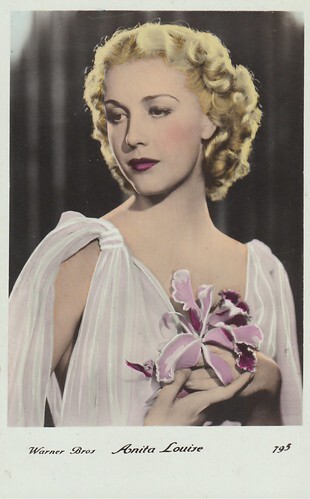
French postcard by Erpé, no. 795. Photo: Warner Bros.
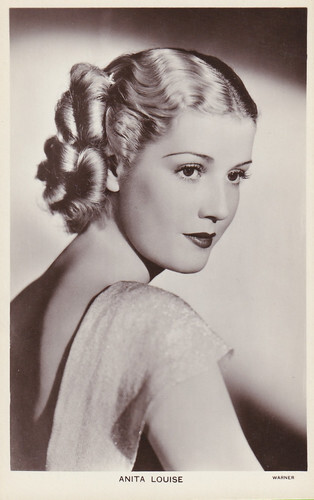
British postcard by Picturegoer, London, no. 512b. Photo: Warner.
An ethereal beauty
From 1934 on, her output of films increased dramatically, and the lovely young star was much in demand.
Anita Louise was featured in, among others, Are We Civilized? (1934), Cross Streets (1934), The Firebird (1934), Bachelor of Arts (1934), Here’s to Romance (1935), Brides Are Like That (1936), Call It a Day (1937), The Go-Getter (1937), Going Places (1938), Hero for a Day (1939), Main Street Lawyer (1939), …
She was Marie Antoinette in Madame du Barry (1934) and, four years later, the queen’s close friend, Princess de Lamballe, in Marie Antoinette (1938).
Her ethereal beauty won her the role of Titania, Queen of Fairies, in A Midsummer Night’s Dream (1935).
She also played opposite Paul Muni in The Story of Louis Pasteur (1936), as his daughter, and Errol Flynn in Green Light (1937), as his love interest.
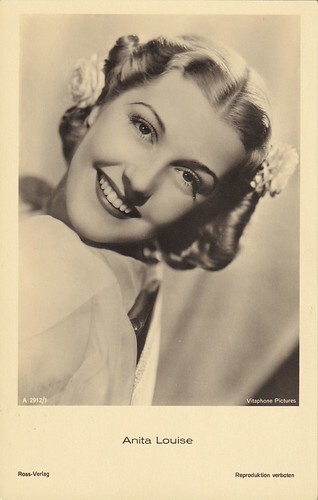
German postcard by Ross Verlag, no. A 2912/1, 1939-1940. Photo: Vitaphone Pictures.
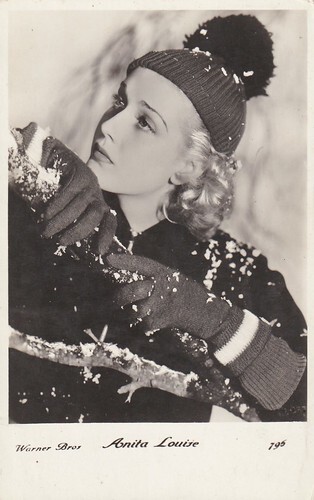
French postcard by Erpé, no. 796. Photo: Warner Bros.
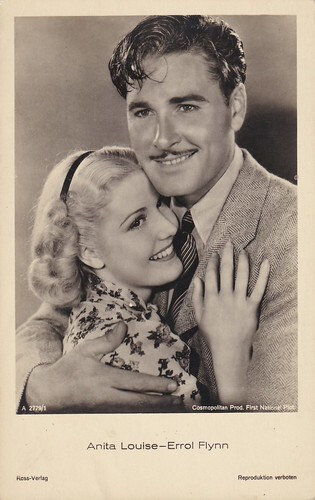
German postcard by Ross Verlag, no. A 2779/1, 1939-1940. Anita Louise and Errol Flynn in Green Light (Frank Borzage, 1937). Photo: Cosmopolitan Productions / First National Pictures.
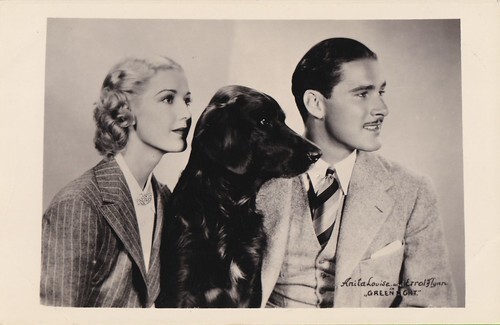
Postcard from the Dutch East Indies (now Indonesia). Anita Louise and Errol Flynn in Green Light (Frank Borzage, 1937).
No Gone with the Wind and Rebecca for Anita Louise.
Anita Louise was among the actresses who screen-tested for the role of Scarlett O’Hara in Gone with the Wind (1939), which eventually went to Vivien Leigh . Selznick also considered her for the leading role in Rebecca (1940).
Director Alfred Hitchcock reckoned that, although she was very interesting and her reading was competent, she didn’t look anything like a paid travelling companion to a pompous and ageing socialite. In short, she was thought too pretty and elegant to play the mousy and unassuming character Laurence Olivier falls in love with at the beginning of the movie, and Selznick finally chose Joan Fontaine.
In the Bette Davis - Errol Flynn vehicle The Sisters (1938), she marries a wealthy man she doesn’t love, just to enjoy a luxurious lifestyle, and it was a departure from her usual ingenue roles. In These Glamour Girls (1939), she played for the first time a wholly unsympathetic character, as a condescending, bitchy and ultra-sophisticated snob being nasty to Lana Turner .
A more mature Anita Louise emerged and pursued her career until 1947 with movies such as Glamour for Sale (1940), The Villain Still Pursued Her (1940), Two in a Taxi (1941), Harmon of Michigan (1941), Dangerous Blondes (1943), Nine Girls (1944), The Fighting Guardsman (1945), The Bandit of Sherwood Forest (1946), The Devil’s Mask (1946), Shadowed (1946), Bulldog Drummond at Bay (1947), …
In the 1940s, Anita Louise didn’t get to appear in the same number of A-pictures as in the 1930s, but she never lacked film offers.
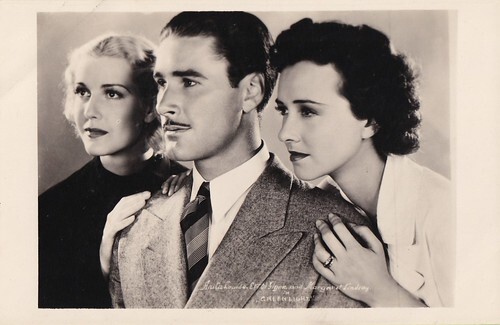
Postcard from the Dutch East Indies (now Indonesia). Anita Louise, Errol Flynn and Margaret Lindsay in Green Light (Frank Borzage, 1937).
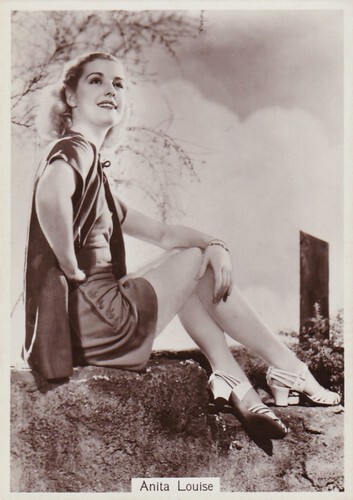
Cigarette card by Godfrey Phillips Ltd. and Associated Company in the Beauties of To-Day series, no. 15, fifth series.
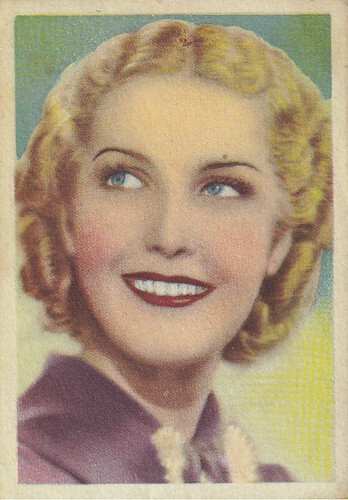
Small Spanish chromo by Editorial Bruguera, Barcelona, in the Cinefoto series.
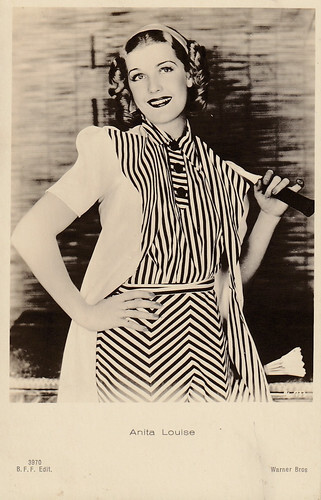
Italian postcard by Ballerini & Fratini, Firenze, no. 3970. Photo: Warner Bros.
Later work and in private
Anita Louise came back on the big screen only once, in Retreat, Hell! (1952).
In the 1950s, she turned to television and was especially noticed as Nell McLaughlin, the young hero’s mother, in the popular series My Friend Flicka, which premiered in February 1956 and lasted 39 episodes. Her other TV appearances include Playhouse 90, The Loretta Young Show and Mannix.
In 1940, she married screenwriter and future producer Buddy Adler. She had a daughter, Melanie, in 1947, and a boy, Anthony, would follow thereafter. Adler died in 1960, and Anita Louise remarried businessman Henry Berger in 1962.
She was active in the film colony’s social scene and was noted for her lavish parties. She also devoted a great deal of her time to promoting charity causes such as the UCLA Medical Center, the National Haemophilia Foundation and the Children’s Asthma Research Center.
Anita Louise died of a stroke on the 25th of April 1970 in Los Angeles.
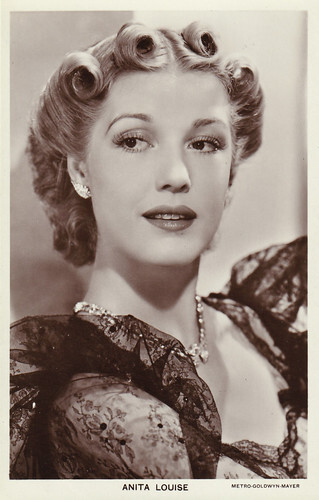
British postcard by Picturegoer, London, no. 512c. Photo: Metro Goldwyn Mayer.
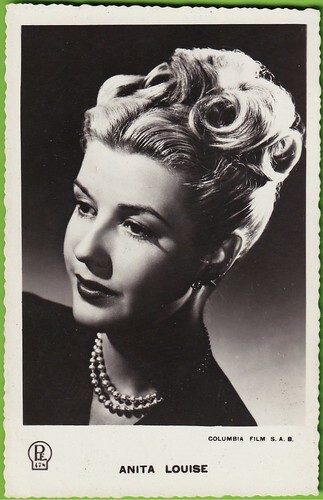
Belgian postcard by Photo Edition, Bruxelles, no. 474. Photo: Columbia Film S.A.B.

Dutch postcard by J.S.A.
Text and postcards: Marlene Pilaete.

British postcard in the Picturegoer Series, London, no. 512.

Spanish postcard by J.D.P., Valencia, no. 2157.

British postcard by Art Photo, no. 114. Photo: Warner Bros. and Vitaphone Pictures.
A child actress growing up
Anita Louise was born Anita Louise Fremault on the 9th of January 1915 in New York City, U.S.A.
Her first movie was Down to the Sea in Ships (1922), in an uncredited bit. As Anita Fremault, she appeared in child roles from 1924 on.
In 1929, she billed herself by her first and second names only and thus became 'Anita Louise'.
Tiffany Studios gave her her first leading roles in Just Like Heaven (1930) and The Third Alarm (1930).
In 1931, she was named one of the WAMPAS Baby Stars. That same year, she notably played Robert Woolsey’s foster daughter in Everybody’s Susie (1931) and was Lew Ayres’s leading lady in Heaven on Earth (1931).

Spanish promotional postcard for A Midsummer Night’s Dream (Max Reinhardt, William Dieterle, 1935), based on the play by William Shakespeare. Photo: Warner Bros / First National. Caption: Al sueno de una noche verano is Spanish for A Midsummer Night’s Dream.

German postcard by Ross Verlag, no. A 1673/1, 1937-1938. Photo: Warner Bros / Vitaphone Pictures.

French postcard by Erpé, no. 795. Photo: Warner Bros.

British postcard by Picturegoer, London, no. 512b. Photo: Warner.
An ethereal beauty
From 1934 on, her output of films increased dramatically, and the lovely young star was much in demand.
Anita Louise was featured in, among others, Are We Civilized? (1934), Cross Streets (1934), The Firebird (1934), Bachelor of Arts (1934), Here’s to Romance (1935), Brides Are Like That (1936), Call It a Day (1937), The Go-Getter (1937), Going Places (1938), Hero for a Day (1939), Main Street Lawyer (1939), …
She was Marie Antoinette in Madame du Barry (1934) and, four years later, the queen’s close friend, Princess de Lamballe, in Marie Antoinette (1938).
Her ethereal beauty won her the role of Titania, Queen of Fairies, in A Midsummer Night’s Dream (1935).
She also played opposite Paul Muni in The Story of Louis Pasteur (1936), as his daughter, and Errol Flynn in Green Light (1937), as his love interest.

German postcard by Ross Verlag, no. A 2912/1, 1939-1940. Photo: Vitaphone Pictures.

French postcard by Erpé, no. 796. Photo: Warner Bros.

German postcard by Ross Verlag, no. A 2779/1, 1939-1940. Anita Louise and Errol Flynn in Green Light (Frank Borzage, 1937). Photo: Cosmopolitan Productions / First National Pictures.

Postcard from the Dutch East Indies (now Indonesia). Anita Louise and Errol Flynn in Green Light (Frank Borzage, 1937).
No Gone with the Wind and Rebecca for Anita Louise.
Anita Louise was among the actresses who screen-tested for the role of Scarlett O’Hara in Gone with the Wind (1939), which eventually went to Vivien Leigh . Selznick also considered her for the leading role in Rebecca (1940).
Director Alfred Hitchcock reckoned that, although she was very interesting and her reading was competent, she didn’t look anything like a paid travelling companion to a pompous and ageing socialite. In short, she was thought too pretty and elegant to play the mousy and unassuming character Laurence Olivier falls in love with at the beginning of the movie, and Selznick finally chose Joan Fontaine.
In the Bette Davis - Errol Flynn vehicle The Sisters (1938), she marries a wealthy man she doesn’t love, just to enjoy a luxurious lifestyle, and it was a departure from her usual ingenue roles. In These Glamour Girls (1939), she played for the first time a wholly unsympathetic character, as a condescending, bitchy and ultra-sophisticated snob being nasty to Lana Turner .
A more mature Anita Louise emerged and pursued her career until 1947 with movies such as Glamour for Sale (1940), The Villain Still Pursued Her (1940), Two in a Taxi (1941), Harmon of Michigan (1941), Dangerous Blondes (1943), Nine Girls (1944), The Fighting Guardsman (1945), The Bandit of Sherwood Forest (1946), The Devil’s Mask (1946), Shadowed (1946), Bulldog Drummond at Bay (1947), …
In the 1940s, Anita Louise didn’t get to appear in the same number of A-pictures as in the 1930s, but she never lacked film offers.

Postcard from the Dutch East Indies (now Indonesia). Anita Louise, Errol Flynn and Margaret Lindsay in Green Light (Frank Borzage, 1937).

Cigarette card by Godfrey Phillips Ltd. and Associated Company in the Beauties of To-Day series, no. 15, fifth series.

Small Spanish chromo by Editorial Bruguera, Barcelona, in the Cinefoto series.

Italian postcard by Ballerini & Fratini, Firenze, no. 3970. Photo: Warner Bros.
Later work and in private
Anita Louise came back on the big screen only once, in Retreat, Hell! (1952).
In the 1950s, she turned to television and was especially noticed as Nell McLaughlin, the young hero’s mother, in the popular series My Friend Flicka, which premiered in February 1956 and lasted 39 episodes. Her other TV appearances include Playhouse 90, The Loretta Young Show and Mannix.
In 1940, she married screenwriter and future producer Buddy Adler. She had a daughter, Melanie, in 1947, and a boy, Anthony, would follow thereafter. Adler died in 1960, and Anita Louise remarried businessman Henry Berger in 1962.
She was active in the film colony’s social scene and was noted for her lavish parties. She also devoted a great deal of her time to promoting charity causes such as the UCLA Medical Center, the National Haemophilia Foundation and the Children’s Asthma Research Center.
Anita Louise died of a stroke on the 25th of April 1970 in Los Angeles.

British postcard by Picturegoer, London, no. 512c. Photo: Metro Goldwyn Mayer.

Belgian postcard by Photo Edition, Bruxelles, no. 474. Photo: Columbia Film S.A.B.

Dutch postcard by J.S.A.
Text and postcards: Marlene Pilaete.
Published on July 30, 2025 22:00
July 29, 2025
More Nos artistes dans leur loge
We are fans of the French postcard series 'Nos artistes dans leur loge'. These cards of French stage and film stars of the 1910s and 1920s in their dressing rooms form a unique and wonderful series. We love these intimate and candid views of legendary French artists - most are now forgotten - with their mirrors, poses, and extravagant costumes. Nearly all of the postcards were produced by the French journal Comoedia. Since 2012, EFSP has regularly posted about the series. During our visit to Noordwijk, Ivo Blom found 19 more cards from the series still missing from his collection.
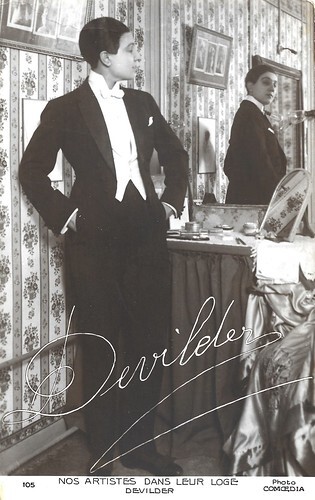
French postcard in the series Nos artistes dans leur loge by Comoedia, no. 105. Photo: Comoedia.
This could be the actress Renée Devilder (?-?). Between 1926 and 1931, she played in various operettas, such as 'No No, Nanette' (1926) and 'Brummel' (1931). In the early 1930s, she acted in seven French musical films. After debuting in a supporting part in the French alternative version Moi et l'impératrice (Friedrich Hollaender, Paul Martin, 1933) starring Lilian Harvey, Devilder had the lead opposite Jean Garat in Cent mille francs pour un baiser (Hubert Bourlon & Georges Delance, 1933). Yet, mostly she played supporting parts.
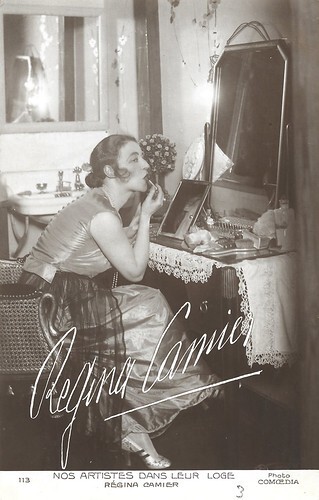
French postcard in the series Nos artistes dans leur loge by Comoedia, no. 113. Photo: Comoedia.
Régina Camier (1894-?) was a French stage and screen actress, famous for her little feet. She had a rich theatre career in the 1920s and 1930s, and at one stage she even owned a theatre. She also directed two operettas in the 1920s, but it is unclear how many films she did. Cine-Ressources indicates only a small part in Par la vérité (1917) by Gaston Leprieur and Maurice de Féraudy.

French postcard in the series Nos artistes dans leur loge by Comoedia, no. 117. Photo: Comoedia.
Eugène Gabriel Mansuelle (1873-1938) began his stage career in 1895, playing in local bawling halls and café-concerts. His popularity was mainly due to his physique - he was overweight, which he used to comic effect. He got into the habit of playing a trumpet solo at the end of his performance, so much so that the audience would shout out ‘Ugène! The trumpet! Mansuelle also had a modest film career. In 1909, he played Mes Bottes in the Zola adaptation L'Assommoir by Albert Capellani for Pathé Frères. In 1916, he played at Pathé Magloire in La Joueuse d'orgue by Georges Denola. In 1917, he acted in Oh! ce baiser!, by René Hervil et Louis Mercanton. In the 1930s, he acted in two French sound films, Amants et voleurs (1935) by Raymond Bernard, and Les Jumeaux de Brighton (1936) by Claude Heymann.
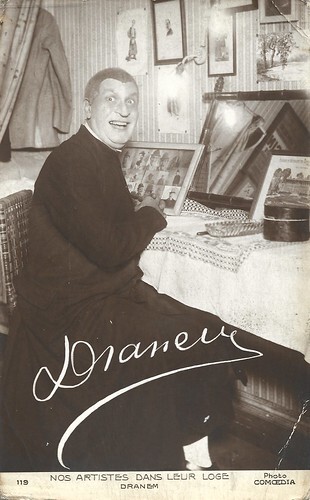
French postcard in the series Nos artistes dans leur loge by Comoedia, no. 119. Photo: Comoedia.
French comic singer, music hall, stage and film actor Dranem (1869-1935) performed in 1895 with fellow newcomers Félix Mayol and Max Dearly in the 'Concert Parisien', from where he went on to become a leading music hall entertainer in his own comic absurdist genre. In 1899, he was signed to perform at the famous Eldorado Club, where he appeared regularly for the next twenty years. Dranem's comedic singing routine brought a loyal following, and his work made him a very wealthy man. Dranem also acted and sang in live theatre and in film. He already acted in 1900 at Pathé in Ma Tante / My Aunt, followed by several silent shorts by Pathé. In 1905, Dranem also performed in a series of 11 early sound films 'phonoscènes' by Gaumont and directed by Alice Guy. The advent of synchronised sound film in the late 1920s made Dranem much in demand for screen roles featuring his singing routines. In the early 1930s, he played in some 13 films, several of which featured him in the lead.
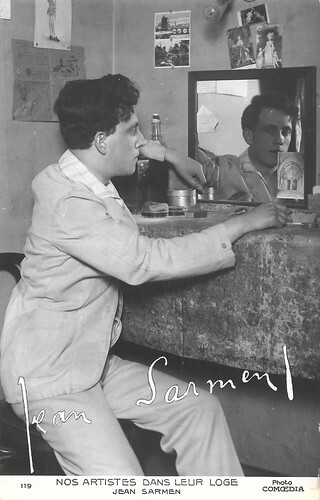
French postcard in the series Nos artistes dans leur loge by Comoedia, no. 119. Photo: Comoedia.
French stage actor Jean Sarment (1897-1976) debuted during the First World War and quickly became a beloved actor by director Jacques Copeau, who had him act in 13 of his plays in 1917-1918 at the Théâtre du Vieux-Colombier in Paris. In 1920, Sarment started stage-writing and directing himself, now at the Théâtre de l'Œuvre, and later at the Théâtre Antoine, often with himself in the male lead. In the early 1930s, he thus acted in his own plays, not only in Paris but also at the Théâtre de Monte-Carlo. In the era of French sound cinema, Sarment collaborated on film scripts or dialogues of various French films, e.g. Un carnet de bal (1937). He scripted and had the lead in the comedy Léopold le bien-aimé (1934), based on a play he had written.
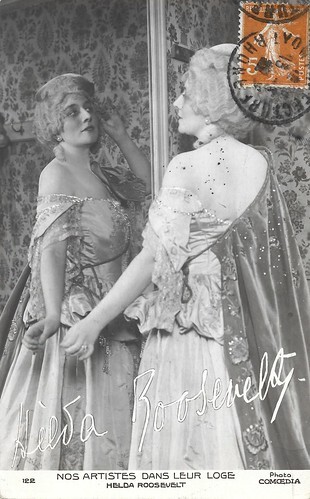
French postcard in the series Nos artistes dans leur loge by Comoedia, no. 122. Photo: Comoedia.
Hilda Roosevelt (1991-1965) was a Parisian opera singer. Though French-born, she was a niece of American President Theodore Roosevelt. In early 1918, she sang in Paris at the Salle Gaveau at a charity for the war effort. In 1919, she debuted as a singer in Paris at the Opéra-Comique, where she worked for years. In 1924, she sang at the Scala in London in 'The Three Musketeers' by Isidore de Lara.
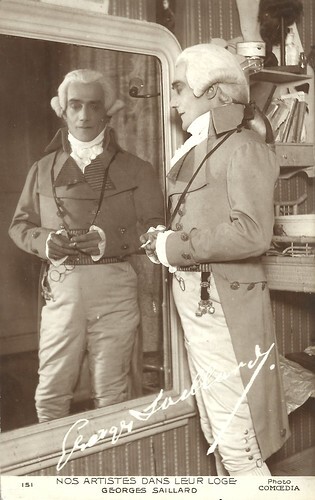
French postcard in the series Nos artistes dans leur loge by Comoedia, no. 151. Photo: Comoedia.
French stage and film actor Georges Saillard (1877-1967) could be seen at the Théâtre Antoine, in plays such as 'Sherlock Holmes' (1907), 'La Femme et le pantin' (1910), and 'Hamlet' (1913). From 1909 on, he also appeared in several early silent Eclair and Pathé productions. After some 23 shorts, Saillard had the lead in the feature Le petit Jacques / Little Jack (Georges Monca, 1913) - in which he is a man unjustly arrested for murder, but trying to protect his child. Saillard returned to the sets in the 1920s, playing, e.g. the evil Thenardier in Les misérables (Henri Fescourt, 1925). Yet, particularly during the 1930s, Saillard played many supporting parts in French sound films, often playing doctors, e.g. the doctor in Yoshiwara (Max Ophüls, 1937) and in Abel Gance's own remake of J'Accuse (1938).
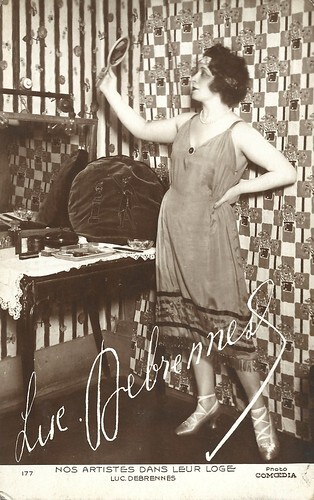
French postcard in the series Nos artistes dans leur loge by Comoedia, no. 177. Photo: Comoedia.
Lucienne Debrenne [without -s] was a French stage actress who acted, e.g. in the comedy 'La Fleur d’oranger', performed in 1924 at the Comédie-Caumartin (Paris). According to IMDb, 'Lucienne Debrienne' acted in the French silent film comedy Bonheur conjugal (Robert Saidreau, 1923). Perhaps this is the same actress.
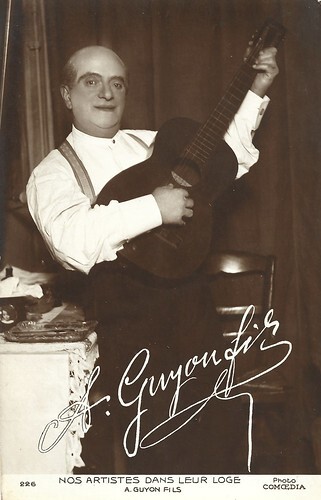
French postcard in the series Nos artistes dans leur loge by Comoedia, no. 226. Photo: Comoedia.
Guyon fils, pseudonym of Charles-Alexandre Guyon (1854-1923), was a French stage and screen actor, born in a family of actors. He made his debut at the Eldorado in 1873. He moved to the Théâtre Beaumarchais in 1880, where he played in the revue 'Madeleine-Bastille', before moving to the Théâtre du Château-d'Eau in 1882, where he created 'Casse-museau. In 1886, he went to the Folies-Dramatiques, where he remained for eight years and created around twenty plays and operettas. Guyon also appeared in six films between 1917 and 1923: La conscience de Monsieur Cachalot (Maurice Poggi, 1917), Le Retour aux champs (Jacques de Baroncelli, 1918), Les Bleus de l'amour (Henri Desfontaines, 1918), Les Cinq gentlemen maudits (Luitz-Morat & Pierre Régnier, 1920), Petit ange (Luitz-Morat & Pierre Régnier, 1920), and Petit ange et son pantin (Luitz-Morat, 1923) - the latter two with little Régine Dumien in the lead.
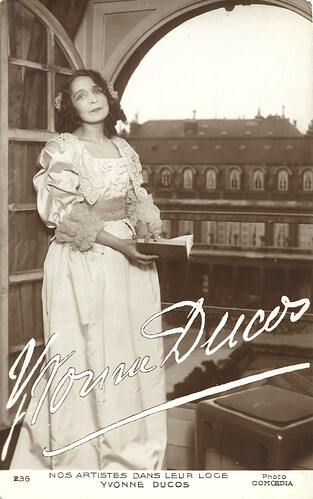
French postcard in the series Nos artistes dans leur loge by Comoedia, no. 236. Photo: Comoedia. The open window may be at the Comédie Française.
Yvonne Ducos (1887-1946) was a French stage actress who also played in four films. Ducos acted at the Comédie Française, where she was 'pensionnaire' between 1911 and 1937, both in modern plays such as 'la Marche nuptiale' (1913) by Henri Bataille as well as classics by Racine ('Esther', 'Iphigenia in Aulis') and Shakespeare ('The Taming of the Shrew). She acted in several Greek plays or reworkings of them, such as 'Elektra', 'Orestes' and, as mentioned, 'Iphigenia in Aulis', or, again, plays set in Ancient Greece ('Psyché', 1918; 'Les Phéniciennes', 1922; 'Les Erinnyes', 1931) or Rome ('L'Hérodienne', 1919). After two shorts in the 1910s, Les Jacobites (Le Film d'Art, 1912) and Les Lettres (Louis Feuillade, Gaumont, 1914), Ducos acted in two sound films, Cognasse (Louis Mercanton, 1932) starring Tramel, and La Troisième Dalle (Michel Dulud, 1946) with Jules Berry.
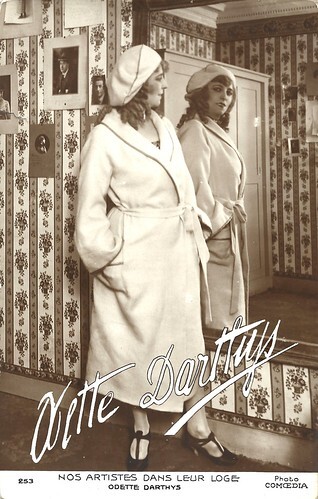
French postcard in the series Nos artistes dans leur loge by Comoedia, no. 253. Photo: Comoedia.
Odette Darthys (?-?) was a French prima donna singer at the Opéra Comique in Paris. Afterwards, she married auto racer Roger Lacor.
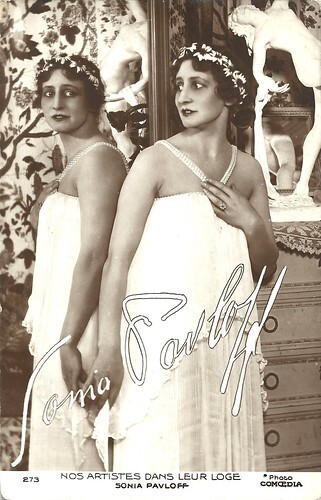
French postcard in the series Nos artistes dans leur loge by Comoedia, no. 273. Photo: Comoedia.
During the 1910s and 1920s, Sonia Pavloff (1885-1938), born in Russia, was a renowned dancer at the Opéra-Comique in Paris.

French postcard in the series Nos artistes dans leur loge by Comoedia, no. 298. Photo: Comoedia.
R. de Boncour (?-?) was a French stage actor in the 1920s, initially mostly at the Théâtre de l'Odéon, and only playing supporting parts. In the press, he was always listed as "R. de Boncour". Little is known about him.
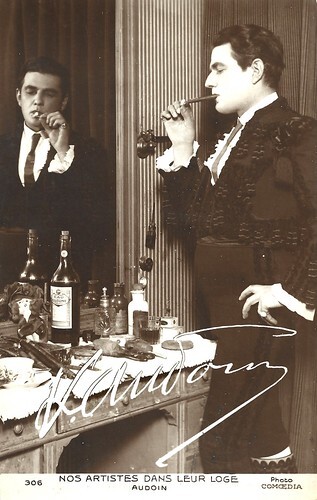
French postcard in the series Nos artistes dans leur loge by Comoedia, no. 306. Photo: Comoedia. Audoin seems to wear a costume fit for the torero in the opera 'Carmen'.
Eric Audoin, aka Audoin (1881-?), was a French tenor. In 1904, he debuted as a singer at the Theatre of Besançon, while he sang at the opera of Nice in 1905-1906. Afterward. Albert Carré hired him for his Opéra-Comique in Paris, where Audoin's part of Don José in 'Carmen' became his most famous role. In 1906, he married the singer Hélène Lassara. In 1925, Audoin had the lead as Lohengrin in the opera by Richard Wagner, performed at the Theatre at Vichy.
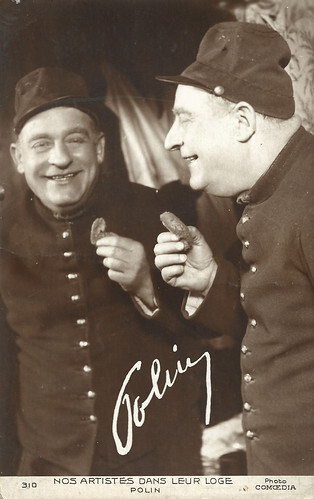
French postcard in the series Nos artistes dans leur loge by Comoedia, no. 310. Photo: Comoedia.
French comedian Polin (1863-1927) was one of the greatest stars of the café-concerts of Paris. His interpretations were sober and had nuance and finesse, which were rare in the café-concerts. From 1910 on, he also appeared in film and theatre, including Sacha Guitry's play Le Grand Duc/The Grand Duke (1921) with Lucien and Sacha Guitry, and Yvonne Printemps.

French postcard in the series Nos artistes dans leur loge by Comoedia, no. 324. Photo: Comoedia.
French stage actor Jean d’Yd (1880-1964) was active between the 1910s and the 1960s. From 1911, he acted in several plays at the Théâtre national de l'Odéon, directed by André Antoine. In the 1920s, he acted in various plays at the Théâtre des Arts, directed by Georges Pitoëff. After the Second World War, he acted in various plays at the Théâtre de l'Athénée, directed by Pierre Blanchar. He was a highly prolific character actor in French cinema. His M. Labas in Germaine Dulac's La souriante Madame Beudet (1923) was immediately followed by Dulac's episode film Gossette (1923). During the 1920s, d'Yd played La Bussière in Abel Gance's Napoléon (1927) and Guillaume Évrard in La Passion de Jeanne d'Arc (1928) by Carl Theodor Dreyer. In the 1930s, he acted in over 15 films in the 1930s, including Les Misérables (1934) by Raymond Bernard. During the war years, he acted in Les Visiteurs du soir (1942) by Marcel Carné and L'Eternel retour (1943) by Jean Delannoy. In the post-war era, he had a major part as the uncle of Marlene Dietrich in Martin Roumagnac (1946) by Georges Lacombe, while he played the father of the family in Les Dernières Vacances (1948) by Robert Leenhardt. All in all, he acted in 56 films until 1959.
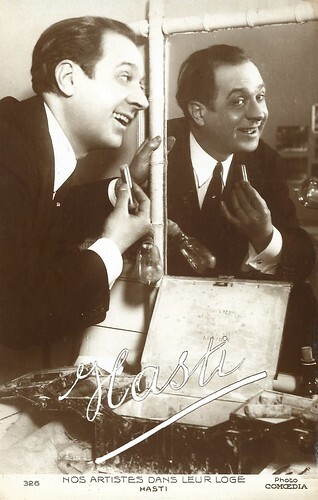
French postcard in the series Nos artistes dans leur loge by Comoedia, no. 326. Photo: Comoedia.
Robert Hista, known as Hasti, acted from 1907 at the Théâtre des Bouffes Parisiens in Paris. Hasti often acted opposite Cora Laparcerie in stage comedies at the same theatre in the pre-WWI years. After the First World War, Hasti acted at the Théâtre national de l'Odéon and other Parisian theatres. His films included L'oeil de Saint Yves (1919) and Les deux jarretières (1919), both with Julian, René Norbert, and Geneviève Félix. In 1920, Hasti acted in Luitz-Morat's comedy Rien à louer, on a modern Robinson Crusoë. In the early 1930s, Hasti returned on screen in five comedies. After the Second World War, Hasti had a last performance in another military comedy, Tire-au-flanc (Fernand Rivers, 1950), a remake of a film by Jean Renoir.
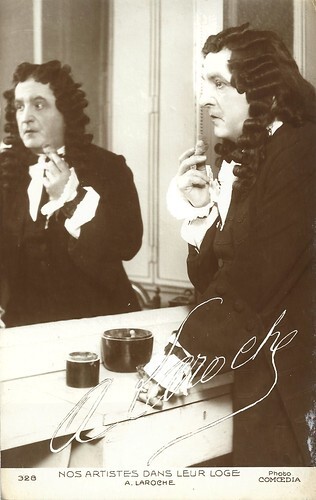
French postcard in the series Nos artistes dans leur loge by Comoedia, no. 328. Photo: Comoedia.
Albert Laroche (1862-?) was a French stage actor whose peak was during the 1890s and 1900s. Laroche acted for years at the Théâtre de la Renaissance, where he had major supporting parts in many plays starring 'la divine' Sarah Bernhardt. When Bernhardt started her own theatre, Laroche had a major part in her 'L'Aiglon' (1900) by Edmond Rostand. In 1907, he reunited with Bernhardt at her theatre for 'Les Bouffons' and 'Adrienne Lecouvreur', and again in 1913 for Jeanne Doré. Yet, at the Théâtre de la Gaîté, he acted in plays with Coquelin ainé in the lead, such as 'Cyrano de Bergerac' (1904) and 'Scarron' (1905). In 1908-1909, he also co-wrote revues for the Scala and the Eldorado in Paris. In the 1910s, Laroche acted at the Odeon theatre, and in 1927, he starred opposite Huguette Duflos in Maurice Donnay's 'Une Revue', at the Théâtre de la Porte Saint Martin. His last performance (as far as known) he gave in 1929 in John Van Druten's play 'Destinée', with Roger Gaillard.
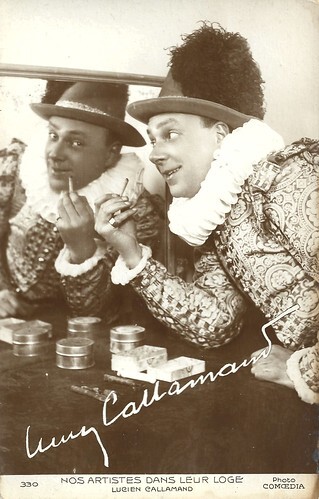
French postcard in the series Nos artistes dans leur loge by Comoedia, no. 330. Photo: Comoedia.
French stage and screen actor Lucien Callamand (1888-1968) had a rich stage career at various Parisian theatres in the 1920s. Yet, it was in the cinema that Callamand had his most prolific career. From 1909, he acted under the name of Paul Lack at Pathé Frères in films by Albert Capellani such as L'Assommoir (1909). Soon, he started to use his own name. In 1911, he launched at Eclipse his comical character of Agénor in Agénor, cavalier de deuxième classe. At Pathé, he played the comic type Narcisse in Narcisse a perdu son oncle (1914). After the introduction of sound film, Callamand became a regular character actor for decades. All in all, Callamand acted in some 145 films, even if some parts were uncredited.
Check out our earlier posts on Nos artistes dans leur loge
Nos artistes sans leur loge (21 November 2012).
New Acquisitions: Nos artistes dans leur loge (9 November 2019).
New Acquisitions: Nos artistes dans leur loge (18 January 2020).
Encore! Nos artistes dans leur loge (17 July 2021).
And check out our Flick Album on Nos artistes dans leur loge .

French postcard in the series Nos artistes dans leur loge by Comoedia, no. 105. Photo: Comoedia.
This could be the actress Renée Devilder (?-?). Between 1926 and 1931, she played in various operettas, such as 'No No, Nanette' (1926) and 'Brummel' (1931). In the early 1930s, she acted in seven French musical films. After debuting in a supporting part in the French alternative version Moi et l'impératrice (Friedrich Hollaender, Paul Martin, 1933) starring Lilian Harvey, Devilder had the lead opposite Jean Garat in Cent mille francs pour un baiser (Hubert Bourlon & Georges Delance, 1933). Yet, mostly she played supporting parts.

French postcard in the series Nos artistes dans leur loge by Comoedia, no. 113. Photo: Comoedia.
Régina Camier (1894-?) was a French stage and screen actress, famous for her little feet. She had a rich theatre career in the 1920s and 1930s, and at one stage she even owned a theatre. She also directed two operettas in the 1920s, but it is unclear how many films she did. Cine-Ressources indicates only a small part in Par la vérité (1917) by Gaston Leprieur and Maurice de Féraudy.

French postcard in the series Nos artistes dans leur loge by Comoedia, no. 117. Photo: Comoedia.
Eugène Gabriel Mansuelle (1873-1938) began his stage career in 1895, playing in local bawling halls and café-concerts. His popularity was mainly due to his physique - he was overweight, which he used to comic effect. He got into the habit of playing a trumpet solo at the end of his performance, so much so that the audience would shout out ‘Ugène! The trumpet! Mansuelle also had a modest film career. In 1909, he played Mes Bottes in the Zola adaptation L'Assommoir by Albert Capellani for Pathé Frères. In 1916, he played at Pathé Magloire in La Joueuse d'orgue by Georges Denola. In 1917, he acted in Oh! ce baiser!, by René Hervil et Louis Mercanton. In the 1930s, he acted in two French sound films, Amants et voleurs (1935) by Raymond Bernard, and Les Jumeaux de Brighton (1936) by Claude Heymann.

French postcard in the series Nos artistes dans leur loge by Comoedia, no. 119. Photo: Comoedia.
French comic singer, music hall, stage and film actor Dranem (1869-1935) performed in 1895 with fellow newcomers Félix Mayol and Max Dearly in the 'Concert Parisien', from where he went on to become a leading music hall entertainer in his own comic absurdist genre. In 1899, he was signed to perform at the famous Eldorado Club, where he appeared regularly for the next twenty years. Dranem's comedic singing routine brought a loyal following, and his work made him a very wealthy man. Dranem also acted and sang in live theatre and in film. He already acted in 1900 at Pathé in Ma Tante / My Aunt, followed by several silent shorts by Pathé. In 1905, Dranem also performed in a series of 11 early sound films 'phonoscènes' by Gaumont and directed by Alice Guy. The advent of synchronised sound film in the late 1920s made Dranem much in demand for screen roles featuring his singing routines. In the early 1930s, he played in some 13 films, several of which featured him in the lead.

French postcard in the series Nos artistes dans leur loge by Comoedia, no. 119. Photo: Comoedia.
French stage actor Jean Sarment (1897-1976) debuted during the First World War and quickly became a beloved actor by director Jacques Copeau, who had him act in 13 of his plays in 1917-1918 at the Théâtre du Vieux-Colombier in Paris. In 1920, Sarment started stage-writing and directing himself, now at the Théâtre de l'Œuvre, and later at the Théâtre Antoine, often with himself in the male lead. In the early 1930s, he thus acted in his own plays, not only in Paris but also at the Théâtre de Monte-Carlo. In the era of French sound cinema, Sarment collaborated on film scripts or dialogues of various French films, e.g. Un carnet de bal (1937). He scripted and had the lead in the comedy Léopold le bien-aimé (1934), based on a play he had written.

French postcard in the series Nos artistes dans leur loge by Comoedia, no. 122. Photo: Comoedia.
Hilda Roosevelt (1991-1965) was a Parisian opera singer. Though French-born, she was a niece of American President Theodore Roosevelt. In early 1918, she sang in Paris at the Salle Gaveau at a charity for the war effort. In 1919, she debuted as a singer in Paris at the Opéra-Comique, where she worked for years. In 1924, she sang at the Scala in London in 'The Three Musketeers' by Isidore de Lara.

French postcard in the series Nos artistes dans leur loge by Comoedia, no. 151. Photo: Comoedia.
French stage and film actor Georges Saillard (1877-1967) could be seen at the Théâtre Antoine, in plays such as 'Sherlock Holmes' (1907), 'La Femme et le pantin' (1910), and 'Hamlet' (1913). From 1909 on, he also appeared in several early silent Eclair and Pathé productions. After some 23 shorts, Saillard had the lead in the feature Le petit Jacques / Little Jack (Georges Monca, 1913) - in which he is a man unjustly arrested for murder, but trying to protect his child. Saillard returned to the sets in the 1920s, playing, e.g. the evil Thenardier in Les misérables (Henri Fescourt, 1925). Yet, particularly during the 1930s, Saillard played many supporting parts in French sound films, often playing doctors, e.g. the doctor in Yoshiwara (Max Ophüls, 1937) and in Abel Gance's own remake of J'Accuse (1938).

French postcard in the series Nos artistes dans leur loge by Comoedia, no. 177. Photo: Comoedia.
Lucienne Debrenne [without -s] was a French stage actress who acted, e.g. in the comedy 'La Fleur d’oranger', performed in 1924 at the Comédie-Caumartin (Paris). According to IMDb, 'Lucienne Debrienne' acted in the French silent film comedy Bonheur conjugal (Robert Saidreau, 1923). Perhaps this is the same actress.

French postcard in the series Nos artistes dans leur loge by Comoedia, no. 226. Photo: Comoedia.
Guyon fils, pseudonym of Charles-Alexandre Guyon (1854-1923), was a French stage and screen actor, born in a family of actors. He made his debut at the Eldorado in 1873. He moved to the Théâtre Beaumarchais in 1880, where he played in the revue 'Madeleine-Bastille', before moving to the Théâtre du Château-d'Eau in 1882, where he created 'Casse-museau. In 1886, he went to the Folies-Dramatiques, where he remained for eight years and created around twenty plays and operettas. Guyon also appeared in six films between 1917 and 1923: La conscience de Monsieur Cachalot (Maurice Poggi, 1917), Le Retour aux champs (Jacques de Baroncelli, 1918), Les Bleus de l'amour (Henri Desfontaines, 1918), Les Cinq gentlemen maudits (Luitz-Morat & Pierre Régnier, 1920), Petit ange (Luitz-Morat & Pierre Régnier, 1920), and Petit ange et son pantin (Luitz-Morat, 1923) - the latter two with little Régine Dumien in the lead.

French postcard in the series Nos artistes dans leur loge by Comoedia, no. 236. Photo: Comoedia. The open window may be at the Comédie Française.
Yvonne Ducos (1887-1946) was a French stage actress who also played in four films. Ducos acted at the Comédie Française, where she was 'pensionnaire' between 1911 and 1937, both in modern plays such as 'la Marche nuptiale' (1913) by Henri Bataille as well as classics by Racine ('Esther', 'Iphigenia in Aulis') and Shakespeare ('The Taming of the Shrew). She acted in several Greek plays or reworkings of them, such as 'Elektra', 'Orestes' and, as mentioned, 'Iphigenia in Aulis', or, again, plays set in Ancient Greece ('Psyché', 1918; 'Les Phéniciennes', 1922; 'Les Erinnyes', 1931) or Rome ('L'Hérodienne', 1919). After two shorts in the 1910s, Les Jacobites (Le Film d'Art, 1912) and Les Lettres (Louis Feuillade, Gaumont, 1914), Ducos acted in two sound films, Cognasse (Louis Mercanton, 1932) starring Tramel, and La Troisième Dalle (Michel Dulud, 1946) with Jules Berry.

French postcard in the series Nos artistes dans leur loge by Comoedia, no. 253. Photo: Comoedia.
Odette Darthys (?-?) was a French prima donna singer at the Opéra Comique in Paris. Afterwards, she married auto racer Roger Lacor.

French postcard in the series Nos artistes dans leur loge by Comoedia, no. 273. Photo: Comoedia.
During the 1910s and 1920s, Sonia Pavloff (1885-1938), born in Russia, was a renowned dancer at the Opéra-Comique in Paris.

French postcard in the series Nos artistes dans leur loge by Comoedia, no. 298. Photo: Comoedia.
R. de Boncour (?-?) was a French stage actor in the 1920s, initially mostly at the Théâtre de l'Odéon, and only playing supporting parts. In the press, he was always listed as "R. de Boncour". Little is known about him.

French postcard in the series Nos artistes dans leur loge by Comoedia, no. 306. Photo: Comoedia. Audoin seems to wear a costume fit for the torero in the opera 'Carmen'.
Eric Audoin, aka Audoin (1881-?), was a French tenor. In 1904, he debuted as a singer at the Theatre of Besançon, while he sang at the opera of Nice in 1905-1906. Afterward. Albert Carré hired him for his Opéra-Comique in Paris, where Audoin's part of Don José in 'Carmen' became his most famous role. In 1906, he married the singer Hélène Lassara. In 1925, Audoin had the lead as Lohengrin in the opera by Richard Wagner, performed at the Theatre at Vichy.

French postcard in the series Nos artistes dans leur loge by Comoedia, no. 310. Photo: Comoedia.
French comedian Polin (1863-1927) was one of the greatest stars of the café-concerts of Paris. His interpretations were sober and had nuance and finesse, which were rare in the café-concerts. From 1910 on, he also appeared in film and theatre, including Sacha Guitry's play Le Grand Duc/The Grand Duke (1921) with Lucien and Sacha Guitry, and Yvonne Printemps.

French postcard in the series Nos artistes dans leur loge by Comoedia, no. 324. Photo: Comoedia.
French stage actor Jean d’Yd (1880-1964) was active between the 1910s and the 1960s. From 1911, he acted in several plays at the Théâtre national de l'Odéon, directed by André Antoine. In the 1920s, he acted in various plays at the Théâtre des Arts, directed by Georges Pitoëff. After the Second World War, he acted in various plays at the Théâtre de l'Athénée, directed by Pierre Blanchar. He was a highly prolific character actor in French cinema. His M. Labas in Germaine Dulac's La souriante Madame Beudet (1923) was immediately followed by Dulac's episode film Gossette (1923). During the 1920s, d'Yd played La Bussière in Abel Gance's Napoléon (1927) and Guillaume Évrard in La Passion de Jeanne d'Arc (1928) by Carl Theodor Dreyer. In the 1930s, he acted in over 15 films in the 1930s, including Les Misérables (1934) by Raymond Bernard. During the war years, he acted in Les Visiteurs du soir (1942) by Marcel Carné and L'Eternel retour (1943) by Jean Delannoy. In the post-war era, he had a major part as the uncle of Marlene Dietrich in Martin Roumagnac (1946) by Georges Lacombe, while he played the father of the family in Les Dernières Vacances (1948) by Robert Leenhardt. All in all, he acted in 56 films until 1959.

French postcard in the series Nos artistes dans leur loge by Comoedia, no. 326. Photo: Comoedia.
Robert Hista, known as Hasti, acted from 1907 at the Théâtre des Bouffes Parisiens in Paris. Hasti often acted opposite Cora Laparcerie in stage comedies at the same theatre in the pre-WWI years. After the First World War, Hasti acted at the Théâtre national de l'Odéon and other Parisian theatres. His films included L'oeil de Saint Yves (1919) and Les deux jarretières (1919), both with Julian, René Norbert, and Geneviève Félix. In 1920, Hasti acted in Luitz-Morat's comedy Rien à louer, on a modern Robinson Crusoë. In the early 1930s, Hasti returned on screen in five comedies. After the Second World War, Hasti had a last performance in another military comedy, Tire-au-flanc (Fernand Rivers, 1950), a remake of a film by Jean Renoir.

French postcard in the series Nos artistes dans leur loge by Comoedia, no. 328. Photo: Comoedia.
Albert Laroche (1862-?) was a French stage actor whose peak was during the 1890s and 1900s. Laroche acted for years at the Théâtre de la Renaissance, where he had major supporting parts in many plays starring 'la divine' Sarah Bernhardt. When Bernhardt started her own theatre, Laroche had a major part in her 'L'Aiglon' (1900) by Edmond Rostand. In 1907, he reunited with Bernhardt at her theatre for 'Les Bouffons' and 'Adrienne Lecouvreur', and again in 1913 for Jeanne Doré. Yet, at the Théâtre de la Gaîté, he acted in plays with Coquelin ainé in the lead, such as 'Cyrano de Bergerac' (1904) and 'Scarron' (1905). In 1908-1909, he also co-wrote revues for the Scala and the Eldorado in Paris. In the 1910s, Laroche acted at the Odeon theatre, and in 1927, he starred opposite Huguette Duflos in Maurice Donnay's 'Une Revue', at the Théâtre de la Porte Saint Martin. His last performance (as far as known) he gave in 1929 in John Van Druten's play 'Destinée', with Roger Gaillard.

French postcard in the series Nos artistes dans leur loge by Comoedia, no. 330. Photo: Comoedia.
French stage and screen actor Lucien Callamand (1888-1968) had a rich stage career at various Parisian theatres in the 1920s. Yet, it was in the cinema that Callamand had his most prolific career. From 1909, he acted under the name of Paul Lack at Pathé Frères in films by Albert Capellani such as L'Assommoir (1909). Soon, he started to use his own name. In 1911, he launched at Eclipse his comical character of Agénor in Agénor, cavalier de deuxième classe. At Pathé, he played the comic type Narcisse in Narcisse a perdu son oncle (1914). After the introduction of sound film, Callamand became a regular character actor for decades. All in all, Callamand acted in some 145 films, even if some parts were uncredited.
Check out our earlier posts on Nos artistes dans leur loge
Nos artistes sans leur loge (21 November 2012).
New Acquisitions: Nos artistes dans leur loge (9 November 2019).
New Acquisitions: Nos artistes dans leur loge (18 January 2020).
Encore! Nos artistes dans leur loge (17 July 2021).
And check out our Flick Album on Nos artistes dans leur loge .
Published on July 29, 2025 22:00
July 28, 2025
Helena Carter
American film actress and model Helena Carter (1923-2000) is best known for her final role as Dr. Patricia Blake in Invaders from Mars (1953). From 1947 to 1953, she appeared in 13 films.
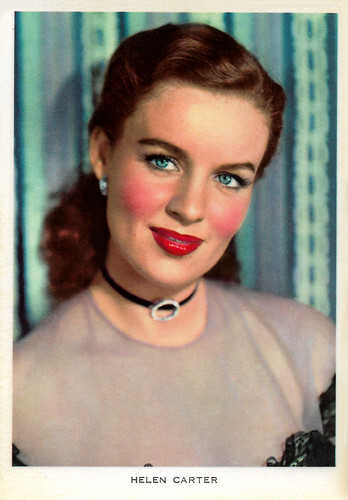
Italian postcard by Nannina, Milano.
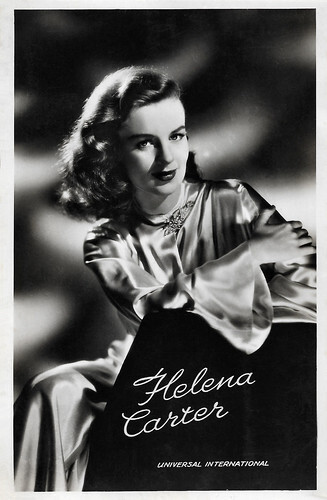
Vintage postcard, no. 3098. Photo: Universal-International.
Beauty, spark and intelligence
Helena Carter was born Helen Jean Ruckert in New York City in 1923. She was the daughter of Lawrence Ruckert and Honorah Sullivan. Helena graduated from Hunter College and attended graduate school at Columbia University, studying for a teaching degree. She later said her ambition was to be a teacher and marry a college professor.
During this period, she worked as a fashion model and modelled sports clothes at Conover, where she became friends with Betsy Drake. Renowned photographer Dick Isaacs shot some magazine covers of her that drew the notice of film studios. Carter was visiting friends at Universal Studios when producer Leonard Goldstein spotted her. Universal signed her to a seven-year contract in 1946.
Her first film role was a small part in the Film Noir Time Out of Mind (Robert Siodmak, 1947), which starred Ella Raines and Phyllis Calvert . The film was Robert Siodmak's one dud in a series of classic Film Noirs. Stephen Vagg at FilmInk : "She already demonstrates what her more notable attributes would be – her beauty, spark and intelligence, and her ability to focus her eyes on the person she was performing a scene with."
Universal put Carter in the musical comedy Something in the Wind (Irving Pichel, 1948) with Deanna Durbin . She was loaned out for the Film Noir Intrigue (Edwin L. Marin, 1948), her biggest part yet. She was billed third after George Raft and June Havoc. Stephen Vagg: "Carter’s performance in this film helped establish what would be her stock in trade character – a good girl sexually attracted to the bad boy hero; moral, but not a stick in the mud; intelligent and spirited. She’s fully present and focused in her scenes with Raft – her eyes are alive, interested, alert; she’s aware, not naive, nobody’s fool."
Back at Universal, she was in the Western River Lady (George Sherman, 1948), vying with Yvonne de Carlo for Rod Cameron. Then she did not work again in a film for over a year. Hedda Hopper reported that Carter became "a little difficult to handle after her first picture. She turned down a part in an Abbott and Costello film and got the silent treatment from the studio for the year. She finally saw the light, started cooperating." The film that brought her back was The Fighting O'Flynn (Arthur Pierson, 1949). She was cast as Douglas Fairbanks Jr 's love interest in the film made for Fairbanks' company but released through Universal. Fairbanks took an option on her for two more films. In 1948, she appeared on the cover of Life.
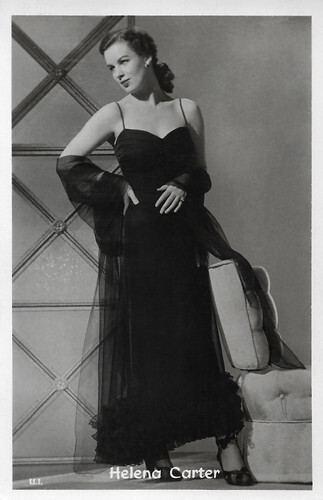
Belgian postcard by Nieuwe Merksemsche Chocolaterie S.P.R.L., Merksem (Antwerp). Photo: Universal-International.
Brave, kind and heroic
Helena Carter turned down the part of Richard Long's wife in Ma and Pa Kettle (Charles Lamont, 1949), and Meg Randall played the role. In November 1948, Hedda Hopper reported that Carter wanted out of her Universal contract six months ago, and would get it if she paid back all the salary she had received. Hopper judged that the studio got enough money out of her loan-outs to Fairbanks and Raft to cover two years of her pay.
Carter wanted better roles, but Universal executives slapped her down. She stayed with Universal and replaced Dolores Hart in South Sea Sinner (H. Bruce Humberstone, 1950). Carter and co-star Shelley Winters reportedly feuded on set, although both denied it. She played the female lead in the comedy Double Crossbones (Charles Barton, 1950), with Donald O'Connor .
James Cagney and his brother, producer William Cagney, borrowed her for the Film Noir Kiss Tomorrow Goodbye (Gordon Douglas, 1950), made by William Cagney Productions for Warner Bros. Carter supported Randolph Scott in the Western Fort Worth (Edwin L. Marin, 1951). William Cagney used her again in the Western Bugles in the Afternoon (Roy Rowland, 1952) with Ray Milland . The story features the Battle of the Little Bighorn.
Sam Katzman used her in the historical adventure film The Golden Hawk (Sidney Salkow, 1952) and the Western The Pathfinder (Sidney Salkow, 1952). Carter's final film was the Sci-Fi thriller Invaders from Mars (William Cameron Menzies, 1953). The film recounts its story from the point of view of an older child in an adult world heading into crisis. It was rushed into production to be released before George Pal's War of the Worlds (also released in 1953), becoming the first feature film to show aliens and their spacecraft in colour. The film developed a cult following in the years after its release.
Stephen Vagg: "For the first time in her entire career, Carter played something other than a love interest for the male lead; she’s the kindly psychiatrist who believes the young boy (Jimmy Hunt) who claims aliens have taken over his parents and helps him investigate. She’s brave, kind and heroic." In 1953, Helena Carter married producer Michael Meshekoff and retired from the film industry. It was her second marriage; the first had ended in divorce. She would remain with Meshekoff until his death in 1997. Three years later, Helena Carter died in Los Angeles, California, in 2000. She was 76.
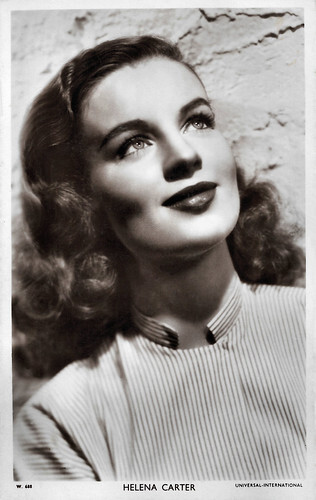
British postcard in the Picturegoer Series, London, no. W 688. Photo: Universal-International.
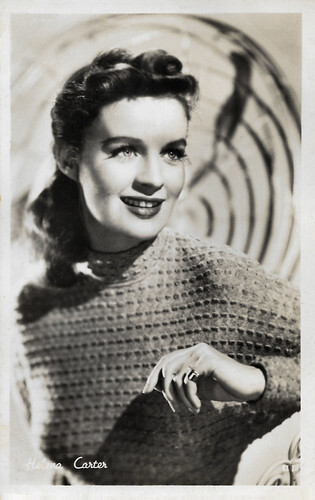
Belgian postcard by Nieuwe Merksemsche Chocolaterie S.P.R.L., Merksem (Anvers). Photo: Universal-International.
Sources: Stephen Vagg (FilmInk), Wikipedia and .

Italian postcard by Nannina, Milano.

Vintage postcard, no. 3098. Photo: Universal-International.
Beauty, spark and intelligence
Helena Carter was born Helen Jean Ruckert in New York City in 1923. She was the daughter of Lawrence Ruckert and Honorah Sullivan. Helena graduated from Hunter College and attended graduate school at Columbia University, studying for a teaching degree. She later said her ambition was to be a teacher and marry a college professor.
During this period, she worked as a fashion model and modelled sports clothes at Conover, where she became friends with Betsy Drake. Renowned photographer Dick Isaacs shot some magazine covers of her that drew the notice of film studios. Carter was visiting friends at Universal Studios when producer Leonard Goldstein spotted her. Universal signed her to a seven-year contract in 1946.
Her first film role was a small part in the Film Noir Time Out of Mind (Robert Siodmak, 1947), which starred Ella Raines and Phyllis Calvert . The film was Robert Siodmak's one dud in a series of classic Film Noirs. Stephen Vagg at FilmInk : "She already demonstrates what her more notable attributes would be – her beauty, spark and intelligence, and her ability to focus her eyes on the person she was performing a scene with."
Universal put Carter in the musical comedy Something in the Wind (Irving Pichel, 1948) with Deanna Durbin . She was loaned out for the Film Noir Intrigue (Edwin L. Marin, 1948), her biggest part yet. She was billed third after George Raft and June Havoc. Stephen Vagg: "Carter’s performance in this film helped establish what would be her stock in trade character – a good girl sexually attracted to the bad boy hero; moral, but not a stick in the mud; intelligent and spirited. She’s fully present and focused in her scenes with Raft – her eyes are alive, interested, alert; she’s aware, not naive, nobody’s fool."
Back at Universal, she was in the Western River Lady (George Sherman, 1948), vying with Yvonne de Carlo for Rod Cameron. Then she did not work again in a film for over a year. Hedda Hopper reported that Carter became "a little difficult to handle after her first picture. She turned down a part in an Abbott and Costello film and got the silent treatment from the studio for the year. She finally saw the light, started cooperating." The film that brought her back was The Fighting O'Flynn (Arthur Pierson, 1949). She was cast as Douglas Fairbanks Jr 's love interest in the film made for Fairbanks' company but released through Universal. Fairbanks took an option on her for two more films. In 1948, she appeared on the cover of Life.

Belgian postcard by Nieuwe Merksemsche Chocolaterie S.P.R.L., Merksem (Antwerp). Photo: Universal-International.
Brave, kind and heroic
Helena Carter turned down the part of Richard Long's wife in Ma and Pa Kettle (Charles Lamont, 1949), and Meg Randall played the role. In November 1948, Hedda Hopper reported that Carter wanted out of her Universal contract six months ago, and would get it if she paid back all the salary she had received. Hopper judged that the studio got enough money out of her loan-outs to Fairbanks and Raft to cover two years of her pay.
Carter wanted better roles, but Universal executives slapped her down. She stayed with Universal and replaced Dolores Hart in South Sea Sinner (H. Bruce Humberstone, 1950). Carter and co-star Shelley Winters reportedly feuded on set, although both denied it. She played the female lead in the comedy Double Crossbones (Charles Barton, 1950), with Donald O'Connor .
James Cagney and his brother, producer William Cagney, borrowed her for the Film Noir Kiss Tomorrow Goodbye (Gordon Douglas, 1950), made by William Cagney Productions for Warner Bros. Carter supported Randolph Scott in the Western Fort Worth (Edwin L. Marin, 1951). William Cagney used her again in the Western Bugles in the Afternoon (Roy Rowland, 1952) with Ray Milland . The story features the Battle of the Little Bighorn.
Sam Katzman used her in the historical adventure film The Golden Hawk (Sidney Salkow, 1952) and the Western The Pathfinder (Sidney Salkow, 1952). Carter's final film was the Sci-Fi thriller Invaders from Mars (William Cameron Menzies, 1953). The film recounts its story from the point of view of an older child in an adult world heading into crisis. It was rushed into production to be released before George Pal's War of the Worlds (also released in 1953), becoming the first feature film to show aliens and their spacecraft in colour. The film developed a cult following in the years after its release.
Stephen Vagg: "For the first time in her entire career, Carter played something other than a love interest for the male lead; she’s the kindly psychiatrist who believes the young boy (Jimmy Hunt) who claims aliens have taken over his parents and helps him investigate. She’s brave, kind and heroic." In 1953, Helena Carter married producer Michael Meshekoff and retired from the film industry. It was her second marriage; the first had ended in divorce. She would remain with Meshekoff until his death in 1997. Three years later, Helena Carter died in Los Angeles, California, in 2000. She was 76.

British postcard in the Picturegoer Series, London, no. W 688. Photo: Universal-International.

Belgian postcard by Nieuwe Merksemsche Chocolaterie S.P.R.L., Merksem (Anvers). Photo: Universal-International.
Sources: Stephen Vagg (FilmInk), Wikipedia and .
Published on July 28, 2025 22:00
July 27, 2025
Tom Selleck
Tom Selleck (1945) is an American actor and film producer, best known for his starring role in the TV series, Magnum, P.I. (1980) and for the box office hit Three Men and a Baby (1987).
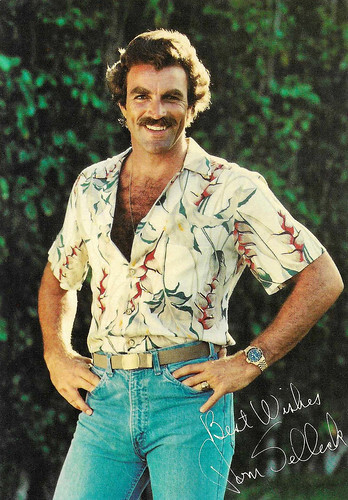
Vintage autograph card.
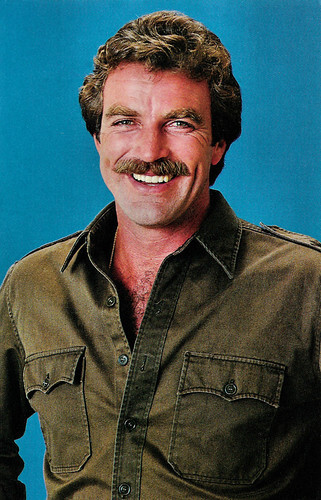
American postcard by Coral-Lee, Rancho Cordova, no. CL/Personality # 111. Photo: Jim McHugh / Contact, 1983.
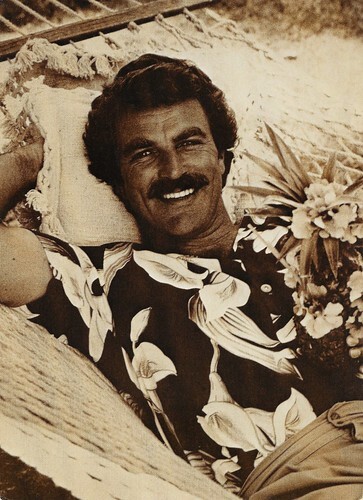
Spanish postcard by Foto Parjetas, Madrid, no. FC-113-50.
A private investigator with a prominent moustache and Hawaiian-style aloha shirtThomas William Selleck was born in Detroit, Michigan, in 1945. His parents were Martha (Jagger), a homemaker, and Robert Dean Selleck, a real estate investor and executive. He has an elder brother, Robert, a younger sister, Martha, and a younger brother, Daniel. He grew up in San Fernando and attended the University of Southern California, where he obtained a degree in English.
A drama coach suggested Selleck try acting, and in his senior year, he dropped out of the university. Selleck then studied acting at the Beverly Hills Playhouse under Milton Katselas. Tom's first television appearance was as a college senior on The Dating Game (1967), but, incredibly, he lost. Soon after, he appeared in television commercials for products such as Pepsi-Cola, and he worked as a male model.
Selleck had small parts in films like the satire Myra Breckinridge (Michael Sarne, 1970), The Seven Minutes (Russ Meyer, 1971) and the conspiracy thriller Coma (Michael Crichton, 1978). He played a leading role in the B-Horror film Daughters of Satan (Hollingsworth Morse, 1972).
Selleck starred in six failed television pilots before he landed his breakthrough role as Hawaii-based private investigator Thomas Magnum on the television series, Magnum, P.I. (1980). With his prominent moustache, Hawaiian-style aloha shirt and Detroit Tigers baseball cap, he became one of the most popular TV stars of the 1980s. For his role, he received five Emmy Award nominations for Outstanding Lead Actor in a Drama Series, winning in 1985.
Selleck was originally cast as Indiana Jones in Raiders of the Lost Ark (Steven Spielberg, 1981), but could not take the role because he was committed to Magnum, P.I. His films included the adventure drama High Road to China (Brian G. Hutton, 1983), the action film Lassiter (Roger Young, 1984) and the romantic comedy Three Men and a Baby (Leonard Nimoy, 1987) with Steve Guttenberg and Ted Danson. The latter was the highest-grossing movie in 1987 and Selleck's most successful film. He again played bachelor architect Peter Mitchell in the sequel 3 Men and a Little Lady (Emile Ardolino, 1990), which was also successful.
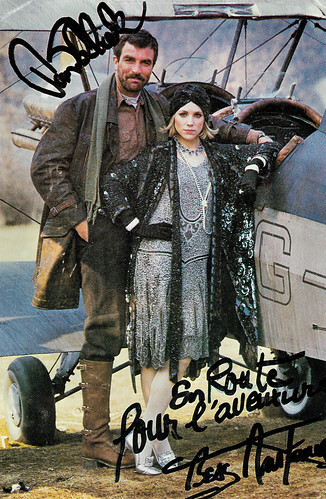
French autograph card for UGC by YF. Tom Selleck and Bess Armstrong in High Road to China (Brian G. Hutton, 1983). The French title was Les aventuriers du bout du monde.
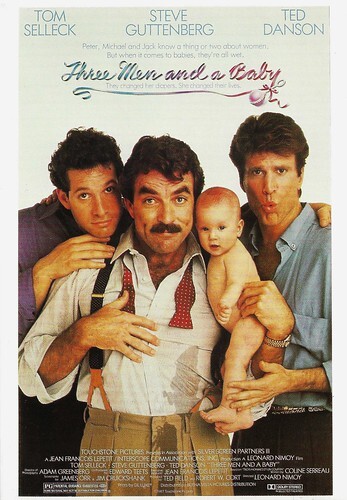
French poster postcard by Editions Avant Garde, no. P533. Tom Selleck, Steve Guttenberg and Ted Danson in Three Men and a Baby (Leonard Nimoy, 1987).
The third person in Razzie history to accept one of the statuettes voluntarily
Tom Selleck appeared extensively on television in roles such as Lance White, the likeable and naive partner on The Rockford Files (1978-1979), as Monica Geller's (Courteney Cox) older love interest, Dr. Richard Burke, in Friends (1994), and as casino owner A.J. Cooper on Las Vegas (2003).
In addition to his series work, Selleck appeared in over fifty films and TV movies, including Quigley Down Under (Simon Wincer, 1990) and the sports comedy Mr. Baseball (Fred Schepisi, 1992). In 1993, he won a Razzie award for Worst Supporting Actor for his performance as King Ferdinand of Spain in Christopher Columbus: The Discovery (John Glen, 1992) starring Marlon Brando . Selleck was the third person in Razzie history to accept one of the statuettes voluntarily.
He shaved off his trademark moustache for the comedy In & Out (Frank Oz, 1997) starring Kevin Kline. Once rarely seen without it, he has since kept it off for most of his stage and screen work. Between 2005 and 2015, Selleck played troubled small-town police chief Jesse Stone in nine television films, based on the Robert B. Parker novels.
From 2010 on, he appeared as Commissioner Frank Reagan in the drama series Blue Bloods (2010-2024) with Donnie Wahlberg. Tom Selleck married model Jacqueline Ray in 1971. They divorced in 1982.
In 1987, he married British dancer Jillie Mack, with whom he has a daughter, Hannah, an international show jumper. Kevin Selleck (1966) is the son of his first wife, Jacqueline Ray, from her first marriage. Tom Selleck adopted Kevin during the marriage and has continued to treat him as a beloved son after he and Ray divorced.
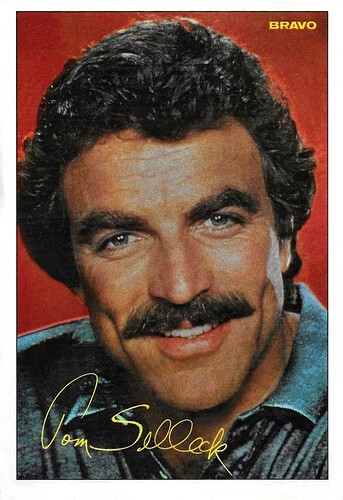
West German collector card by Bravo, 1984.
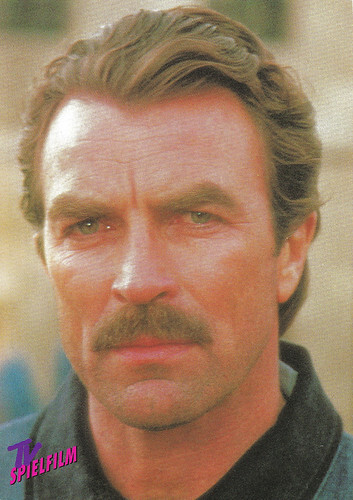
West German collector card by TV Spielfilm.
Sources: Wikipedia and .

Vintage autograph card.

American postcard by Coral-Lee, Rancho Cordova, no. CL/Personality # 111. Photo: Jim McHugh / Contact, 1983.

Spanish postcard by Foto Parjetas, Madrid, no. FC-113-50.
A private investigator with a prominent moustache and Hawaiian-style aloha shirtThomas William Selleck was born in Detroit, Michigan, in 1945. His parents were Martha (Jagger), a homemaker, and Robert Dean Selleck, a real estate investor and executive. He has an elder brother, Robert, a younger sister, Martha, and a younger brother, Daniel. He grew up in San Fernando and attended the University of Southern California, where he obtained a degree in English.
A drama coach suggested Selleck try acting, and in his senior year, he dropped out of the university. Selleck then studied acting at the Beverly Hills Playhouse under Milton Katselas. Tom's first television appearance was as a college senior on The Dating Game (1967), but, incredibly, he lost. Soon after, he appeared in television commercials for products such as Pepsi-Cola, and he worked as a male model.
Selleck had small parts in films like the satire Myra Breckinridge (Michael Sarne, 1970), The Seven Minutes (Russ Meyer, 1971) and the conspiracy thriller Coma (Michael Crichton, 1978). He played a leading role in the B-Horror film Daughters of Satan (Hollingsworth Morse, 1972).
Selleck starred in six failed television pilots before he landed his breakthrough role as Hawaii-based private investigator Thomas Magnum on the television series, Magnum, P.I. (1980). With his prominent moustache, Hawaiian-style aloha shirt and Detroit Tigers baseball cap, he became one of the most popular TV stars of the 1980s. For his role, he received five Emmy Award nominations for Outstanding Lead Actor in a Drama Series, winning in 1985.
Selleck was originally cast as Indiana Jones in Raiders of the Lost Ark (Steven Spielberg, 1981), but could not take the role because he was committed to Magnum, P.I. His films included the adventure drama High Road to China (Brian G. Hutton, 1983), the action film Lassiter (Roger Young, 1984) and the romantic comedy Three Men and a Baby (Leonard Nimoy, 1987) with Steve Guttenberg and Ted Danson. The latter was the highest-grossing movie in 1987 and Selleck's most successful film. He again played bachelor architect Peter Mitchell in the sequel 3 Men and a Little Lady (Emile Ardolino, 1990), which was also successful.

French autograph card for UGC by YF. Tom Selleck and Bess Armstrong in High Road to China (Brian G. Hutton, 1983). The French title was Les aventuriers du bout du monde.

French poster postcard by Editions Avant Garde, no. P533. Tom Selleck, Steve Guttenberg and Ted Danson in Three Men and a Baby (Leonard Nimoy, 1987).
The third person in Razzie history to accept one of the statuettes voluntarily
Tom Selleck appeared extensively on television in roles such as Lance White, the likeable and naive partner on The Rockford Files (1978-1979), as Monica Geller's (Courteney Cox) older love interest, Dr. Richard Burke, in Friends (1994), and as casino owner A.J. Cooper on Las Vegas (2003).
In addition to his series work, Selleck appeared in over fifty films and TV movies, including Quigley Down Under (Simon Wincer, 1990) and the sports comedy Mr. Baseball (Fred Schepisi, 1992). In 1993, he won a Razzie award for Worst Supporting Actor for his performance as King Ferdinand of Spain in Christopher Columbus: The Discovery (John Glen, 1992) starring Marlon Brando . Selleck was the third person in Razzie history to accept one of the statuettes voluntarily.
He shaved off his trademark moustache for the comedy In & Out (Frank Oz, 1997) starring Kevin Kline. Once rarely seen without it, he has since kept it off for most of his stage and screen work. Between 2005 and 2015, Selleck played troubled small-town police chief Jesse Stone in nine television films, based on the Robert B. Parker novels.
From 2010 on, he appeared as Commissioner Frank Reagan in the drama series Blue Bloods (2010-2024) with Donnie Wahlberg. Tom Selleck married model Jacqueline Ray in 1971. They divorced in 1982.
In 1987, he married British dancer Jillie Mack, with whom he has a daughter, Hannah, an international show jumper. Kevin Selleck (1966) is the son of his first wife, Jacqueline Ray, from her first marriage. Tom Selleck adopted Kevin during the marriage and has continued to treat him as a beloved son after he and Ray divorced.

West German collector card by Bravo, 1984.

West German collector card by TV Spielfilm.
Sources: Wikipedia and .
Published on July 27, 2025 22:00
July 26, 2025
Rudolf Lenz
Austrian actor Rudolf Lenz (1920-1987) was the star of the Heimatfilm. In the 1970s he returned to the screen in films and TV series by Rainer Werner Fassbinder.
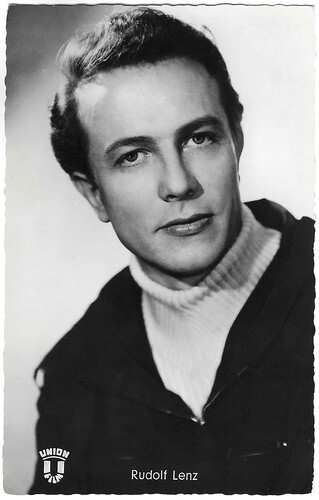
West German postcard by Kolibri-Verlag, Minden/Westf, no. 2131. Photo: Wanke / Cordialfilm / Union-Film. Rudolf Lenz in Liebe, Schnee und Sonnenschein / Love, Snow and Sunshine (Rudolf Nussgruber, 1956).
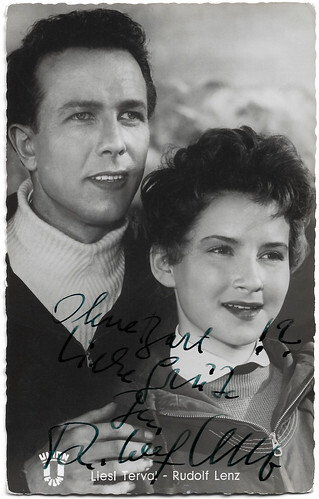
West German postcard by Kolibri-Verlag G.m.b.H., Minden/Westf., no. 2129. Photo: Wanke / Cordinal-Film / Union Film. Photo: Union-Film. Liesl Terval and Rudolf Lenz in Liebe, Schnee und Sonnenschein / Love, Snow and Sunshine (Rudolf Nussgruber, 1956).

West German postcard by Kolibri-Verlag G.m.b.H., Minden/Westf., no. 2094. Photo: Wanke / Cordinal-Film / Union Film. Anita Gutwell, Rudolf Lenz and Liesl Terval in Liebe, Schnee und Sonnenschein / Love, Snow and Sunshine (Rudolf Nussgruber, 1956).
The virile romantic lead of the Austrian Heimatfilm
Rudolf Lenz was born in 1920 in Graz, Austria. He was the son of motorbike manufacturer and engineer Rudolf Lenz and his wife Antonia, née Weiser. He studied mechanical engineering and served as a ship's engineer in the merchant navy from 1941 to 1945.
After the Second World War, Lenz came to the theatre through his aunt, the drama teacher Lore Weiser. He took acting lessons with Professor Kirchner in Vienna, made his debut at the Städtische Bühnen Graz in 1950 and then played at the Stadttheater Klagenfurt.
From 1952 to 1958, he was engaged as a young hero and lover at the Theater in der Josefstadt in Vienna. Parallel to his stage work, Lenz worked as a dubbing actor, for example in Tiefland, by and with Leni Riefenstahl, and also took on his first smaller roles in films. He received his first leading film role opposite Anita Gutwell in the Austrian Heimatfilm Echo der Berge / Der Förster vom Silberwald / Echo of the Mountains (Alfons Stummer, 1954).
Stephanie d'Heil at Steffi-Line : "Der Förster vom Silberwald was a huge success and, alongside Schwarzwaldmädel (1950) and Grün ist die Heide (1951), was one of the biggest box office hits of the 1950s and Lenz became the star of the Heimatfilm, which experienced an unexpected upswing thanks to the actor. The romantic romance between the forester Hubert and the Viennese artist Liesl (Anita Gutwell) is framed by marvellous animal and landscape shots, which are among the most beautiful that the Heimatfilm has to offer."
Lenz went on to star as a virile romantic lead in around thirty more Heimat films, set in rural Austria or southern Germany, which built on his original success. Gutwell and Lenz became a popular couple in the genre. In the next years, Lenz appeared in such films as Mädchenjahre einer Königin / Victoria in Dover (Ernst Marischka, 1954) starring Romy Schneider as the young Queen Victoria, Die Sennerin von St. Kathrein / The Milkmaid of St. Kathrein (Herbert B. Fredersdorf, 1955) in which he reunited with Anita Gutwell, and Der Jäger von Fall / The Hunter of Fall (Gustav Ucicky, 1956).
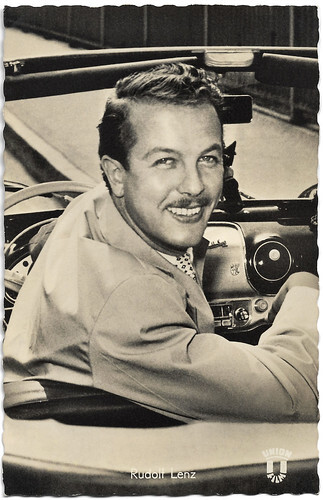
West German postcard by Kolibri-Verlag, Minden/Westf, no. 1824. Photo: Union-Film.
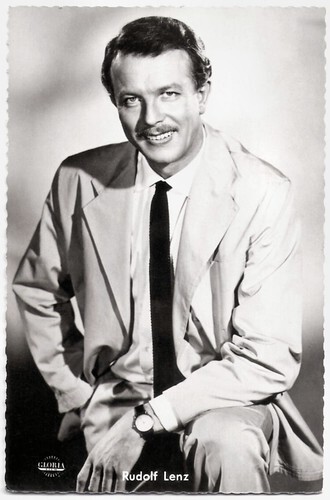
West German postcard by Kolibri-Verlag, Minden/Westf., no. 248. Photo: Divina / Gloria-Film / Bayer. Rudolf Lenz in Heimatlos / Homeless (Herbert B. Fredersdorf, 1958).
A limited comeback with supporting parts in Fassbinder films
When the wave of Heimat films in German-speaking countries began to wane, Rudolf Lenz's star also began to wane. Lenz tried his hand at presenting a travel series on television, went on tour with tabloid plays, ran an antique shop in Munich specialising in English furniture and was moderately successful as a seller of investment certificates.
In the early 1970s, Rudolf Lenz made a limited comeback with supporting parts in two West German TV series directed by Rainer Werner Fassbinder , Acht Stunden sind kein Tag (Rainer Werner Fassbinder, 1972) and the Science Fiction television serial Welt am Draht / World on a Wire (Rainer Werner Fassbinder, 1973), starring Klaus Löwitsch.
These appearances were followed by more supporting roles in Fassbinder's TV film Martha (Rainer Werner Fassbinder, 1974) with Margit Carstensen, and the literature adaptation Fontane Effi Briest (Rainer Werner Fassbinder, 1974). Lenz also appeared in Fassbinder's drama Faustrecht der Freiheit / Fox and His Friends (Rainer Werner Fassbinder, 1975) about the misadventures of a working-class gay man who wins the lottery, and Lili Marleen (Rainer Werner Fassbinder, 1981).
He also had a supporting part in the West German comedy Die wilden Fünfziger / The Roaring Fifties (Peter Zadek, 1983). Based on the novel 'Hurra, wir leben noch' by Johannes Mario Simmel, it is set around the German Wirtschaftswunder economic miracle of the 1950s.
From 1980, he ran a naturopathic practice in Munich together with his ex-wife and her husband. He enjoyed chatting about their ‘marriage of three’ on talk shows. Lenz was divorced twice and had a daughter. Rudolf Lenz died in 1987 in Inzell, Bavaria, West Germany. He was 67 and is interred in the cemetery in Inzell.
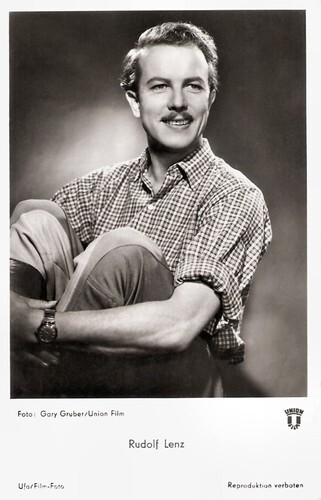
West German postcard by Ufa/Film-Foto, Berlin-Tempelhof, no. FK 2020. Photo: Gary Gruber / Union-Film.
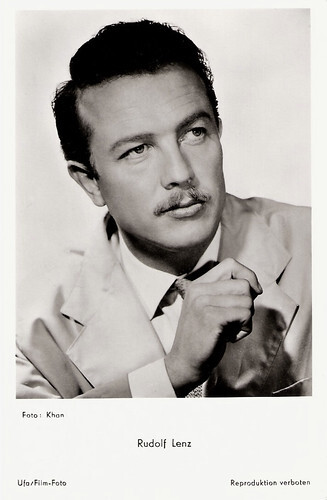
West German postcard by Ufa/Film-Foto, Berlin-Tempelhof, no. FK 3976. Photo: Khan.
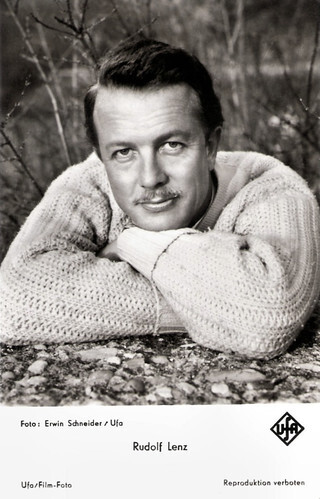
West German postcard by Ufa/Film-Foto, Berlin-Tempelhof, no. FK 4499. Photo: Erwin Schneider / Ufa.
Sources: Stephanie d'Heil (Steffi-Line), Wikipedia (German and English) and .

West German postcard by Kolibri-Verlag, Minden/Westf, no. 2131. Photo: Wanke / Cordialfilm / Union-Film. Rudolf Lenz in Liebe, Schnee und Sonnenschein / Love, Snow and Sunshine (Rudolf Nussgruber, 1956).

West German postcard by Kolibri-Verlag G.m.b.H., Minden/Westf., no. 2129. Photo: Wanke / Cordinal-Film / Union Film. Photo: Union-Film. Liesl Terval and Rudolf Lenz in Liebe, Schnee und Sonnenschein / Love, Snow and Sunshine (Rudolf Nussgruber, 1956).

West German postcard by Kolibri-Verlag G.m.b.H., Minden/Westf., no. 2094. Photo: Wanke / Cordinal-Film / Union Film. Anita Gutwell, Rudolf Lenz and Liesl Terval in Liebe, Schnee und Sonnenschein / Love, Snow and Sunshine (Rudolf Nussgruber, 1956).
The virile romantic lead of the Austrian Heimatfilm
Rudolf Lenz was born in 1920 in Graz, Austria. He was the son of motorbike manufacturer and engineer Rudolf Lenz and his wife Antonia, née Weiser. He studied mechanical engineering and served as a ship's engineer in the merchant navy from 1941 to 1945.
After the Second World War, Lenz came to the theatre through his aunt, the drama teacher Lore Weiser. He took acting lessons with Professor Kirchner in Vienna, made his debut at the Städtische Bühnen Graz in 1950 and then played at the Stadttheater Klagenfurt.
From 1952 to 1958, he was engaged as a young hero and lover at the Theater in der Josefstadt in Vienna. Parallel to his stage work, Lenz worked as a dubbing actor, for example in Tiefland, by and with Leni Riefenstahl, and also took on his first smaller roles in films. He received his first leading film role opposite Anita Gutwell in the Austrian Heimatfilm Echo der Berge / Der Förster vom Silberwald / Echo of the Mountains (Alfons Stummer, 1954).
Stephanie d'Heil at Steffi-Line : "Der Förster vom Silberwald was a huge success and, alongside Schwarzwaldmädel (1950) and Grün ist die Heide (1951), was one of the biggest box office hits of the 1950s and Lenz became the star of the Heimatfilm, which experienced an unexpected upswing thanks to the actor. The romantic romance between the forester Hubert and the Viennese artist Liesl (Anita Gutwell) is framed by marvellous animal and landscape shots, which are among the most beautiful that the Heimatfilm has to offer."
Lenz went on to star as a virile romantic lead in around thirty more Heimat films, set in rural Austria or southern Germany, which built on his original success. Gutwell and Lenz became a popular couple in the genre. In the next years, Lenz appeared in such films as Mädchenjahre einer Königin / Victoria in Dover (Ernst Marischka, 1954) starring Romy Schneider as the young Queen Victoria, Die Sennerin von St. Kathrein / The Milkmaid of St. Kathrein (Herbert B. Fredersdorf, 1955) in which he reunited with Anita Gutwell, and Der Jäger von Fall / The Hunter of Fall (Gustav Ucicky, 1956).

West German postcard by Kolibri-Verlag, Minden/Westf, no. 1824. Photo: Union-Film.

West German postcard by Kolibri-Verlag, Minden/Westf., no. 248. Photo: Divina / Gloria-Film / Bayer. Rudolf Lenz in Heimatlos / Homeless (Herbert B. Fredersdorf, 1958).
A limited comeback with supporting parts in Fassbinder films
When the wave of Heimat films in German-speaking countries began to wane, Rudolf Lenz's star also began to wane. Lenz tried his hand at presenting a travel series on television, went on tour with tabloid plays, ran an antique shop in Munich specialising in English furniture and was moderately successful as a seller of investment certificates.
In the early 1970s, Rudolf Lenz made a limited comeback with supporting parts in two West German TV series directed by Rainer Werner Fassbinder , Acht Stunden sind kein Tag (Rainer Werner Fassbinder, 1972) and the Science Fiction television serial Welt am Draht / World on a Wire (Rainer Werner Fassbinder, 1973), starring Klaus Löwitsch.
These appearances were followed by more supporting roles in Fassbinder's TV film Martha (Rainer Werner Fassbinder, 1974) with Margit Carstensen, and the literature adaptation Fontane Effi Briest (Rainer Werner Fassbinder, 1974). Lenz also appeared in Fassbinder's drama Faustrecht der Freiheit / Fox and His Friends (Rainer Werner Fassbinder, 1975) about the misadventures of a working-class gay man who wins the lottery, and Lili Marleen (Rainer Werner Fassbinder, 1981).
He also had a supporting part in the West German comedy Die wilden Fünfziger / The Roaring Fifties (Peter Zadek, 1983). Based on the novel 'Hurra, wir leben noch' by Johannes Mario Simmel, it is set around the German Wirtschaftswunder economic miracle of the 1950s.
From 1980, he ran a naturopathic practice in Munich together with his ex-wife and her husband. He enjoyed chatting about their ‘marriage of three’ on talk shows. Lenz was divorced twice and had a daughter. Rudolf Lenz died in 1987 in Inzell, Bavaria, West Germany. He was 67 and is interred in the cemetery in Inzell.

West German postcard by Ufa/Film-Foto, Berlin-Tempelhof, no. FK 2020. Photo: Gary Gruber / Union-Film.

West German postcard by Ufa/Film-Foto, Berlin-Tempelhof, no. FK 3976. Photo: Khan.

West German postcard by Ufa/Film-Foto, Berlin-Tempelhof, no. FK 4499. Photo: Erwin Schneider / Ufa.
Sources: Stephanie d'Heil (Steffi-Line), Wikipedia (German and English) and .
Published on July 26, 2025 22:00
July 25, 2025
Irene von Meyendorff
Baroness Irene von Meyendorff (1916-2001) never planned to become a film star, but she appeared in more than 40 films. Unexpectedly, the breathtakingly beautiful, cool blonde became a star of the Ufa in the 1940s. Her beauty attracted Josef Goebbels, who got a harsh rebuff from her. After the war, she played several parts in interesting German films and led a full, remarkable life.
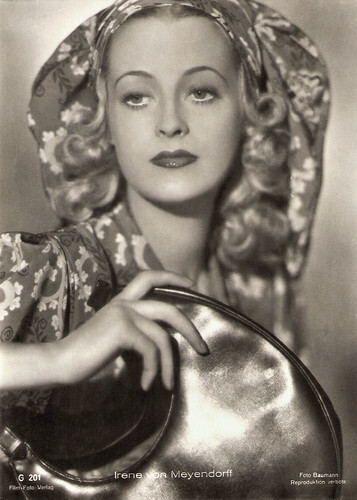
German postcard by Film-Foto-Verlag, no. G 201, 1941-1944. Photo: Foto Baumann.
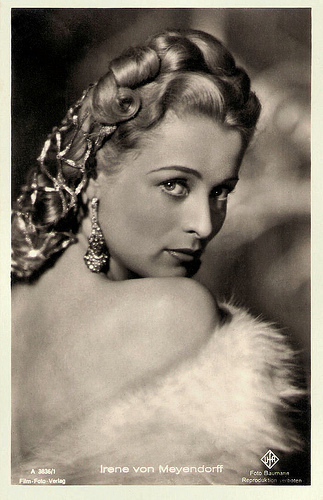
German postcard by Film-Foto-Verlag, no. A 3836/1, 1941-1944. Photo: Baumann. / Ufa. From Tatiana.
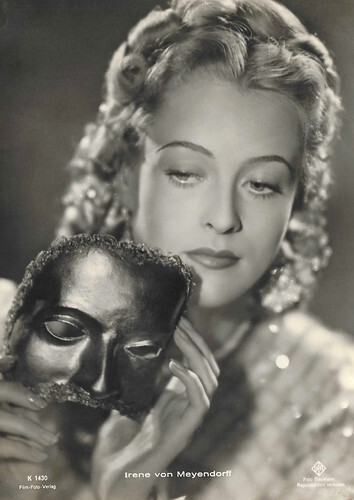
Big German postcard by Film-Foto-Verlag, no. K 1430. Photo: Baumann / Ufa.
The horny goat of Babelsberg
Irene von Meyendorff was born as Irene Isabella Margarethe Paulina Caecilia Freiin von Meyendorff in Reval, Russian Empire (now Tallinn, Estonia) in 1916. She was the eldest child of a German-Baltic aristocrat. After the October Revolution, the family fled to Bremen in Germany. There Irene's mother Elisabeth left her conservative husband with the children to live an unconventional life in the theatre circles of Weimar/Thuringia.
In the early 1930s, Irene went to Berlin to work as a cutter in the Ufa film studios of Babelsberg. Breathtakingly beautiful, she was soon discovered for the screen. Her debut was a mediocre Swashbuckler, Die letzten Vier von Santa Cruz/The Last Four of Santa Cruz (Werner Klingler, 1936), which unexpectedly made her a star.
She then appeared with Lída Baarová in Verräter/The Traitor (Karl Ritter, 1936), and with Hans Albers and Françoise Rosay in the circus film Fahrendes Volk/People Who Travel (Jacques Feyder, 1938). Von Meyendorff starred opposite Erich Ponto in Schneider Wibbel/Tailor Wibbel ( Viktor de Kowa , 1939) based on a script by Helmut Käutner , and she appeared opposite Hans Moser in the comedy Einmal der liebe Herrgott sein/To Be God For Once (Hans H. Zerlett, 1942). She also starred in operetta films such as Frau Luna/Lady Luna ( Theo Lingen , 1943) with Lizzi Waldmüller .
Maybe her best part during this period was the noble Hamburg Patrician daughter Octavia in Veit Harlan 's Opfergang/The Great Sacrifice (1944) with Carl Raddatz and Kristina Söderbaum . She also appeared in Harlan’s Propaganda film Kolberg/Burning Hearts (Veit Harlan, 1945) starring Söderbaum and Heinrich George . This film was the pride and joy of the Nazi propaganda machine. It was filmed during the last year of the war. Lavish financial and material resources were expended to produce the film, and it premiered just ahead of the advancing Allied armies.
Von Meyendorff never was a sympathiser of the Nazi system though. Her first husband, Dr. Heinz Zahler, was a member of the Kreisau Circle, a group of religiously motivated anti-Nazi-bourgeois. Her beauty attracted Josef Goebbels, minister of propaganda, who got a harsh rebuff from her ("You would degrade me - and you would degrade yourself"), according to her own recollections. Reportedly, Goebbels's nasty nick name ‘Bock von Babelsberg' (Horny Goat of Babelsberg) was Irene's creation.
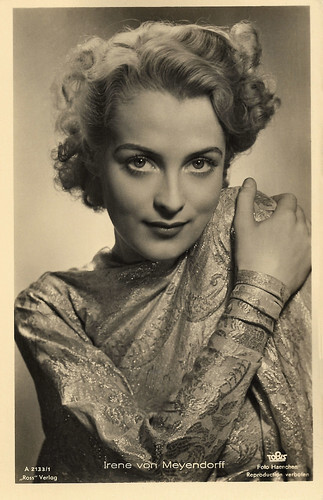
German postcard by Ross Verlag, no. A 2133/1, 1939-1940. Photo: Haenchen / Tobis.
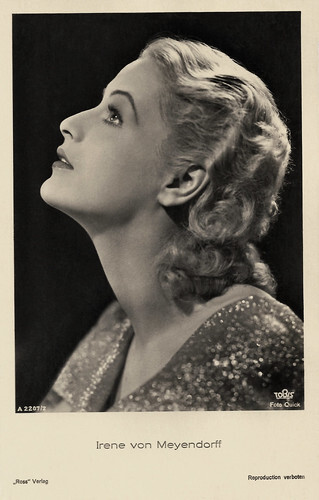
German postcard by Ross Verlag, no. A 2207/2, 1939-1940. Photo: Quick / Tobis.
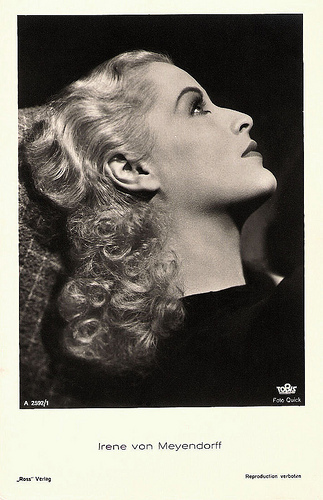
German postcard by Ross Verlag, no. A 2592/1, 1939-1940. Photo: Quick / Tobis.
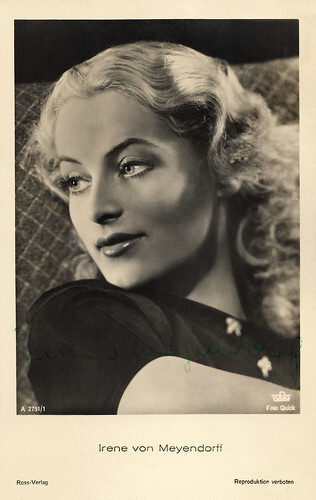
German postcard by Ross Verlag, no. A 2751/1, 1939-1940. Photo: Quick / Tobis.
A modern Adam and Eve
Between 1946 and 1949, some German films showed the will not to just simply go on like nothing happened but to search for new forms of entertainment in the light of the Second World War and the guilt of the German people. Irene von Meyendorff starred in one of these films, Film ohne Titel/Film Without a Title (Rudolf Jugert, 1948) with Hans Söhnker and Hildegard Knef .
Reviewer Herbert Schwaab writes at IMDb that the film is an "interesting reflection about the rights to be entertained: Which stories can be told, when all stories seem to have been finished? It shows the attempts of a film crew to shoot a film. They offer several versions of one simple love story in different film forms (melodrama or German expressionism) until they come out with the right form (which is this film itself)."
That same year, she was also seen in the Biopic The Mozart Story (Karl Hartl, Frank Wisbar, 1948) featuring Hans Holt . This was an Austrian film that was begun by Karl Hartl before World War II, but was shelved, unfinished, when the war began. After the war, the American rights to the film were purchased by Screen Guild. American-German director Frank Wisbar supervised the English dubbing and even added some new scenes, with Wilton Graff as Mozart's great rival, Antonio Salieri. The result was released as a new film, when it was actually at least 10 years old. Hal Erickson at AllMovie comments: “Despite its patchwork construction, The Mozart Story weaves a cogent and credible (if not altogether accurate) version of Mozart's life and work.”
Another interesting film was Der Apfel ist Ab/The Original Sin (Helmut Käutner, 1948), a fantasy about a modern Adam and Eve. The next year she played the lead role in the comedy Einmaleins der Ehe/1 x 1 of the Marriage (Rudolf Jugert, 1949) opposite Hans Söhnker and in 1950 she co-starred in Epilog: Das Geheimnis der Orplid/Epilogue (Helmut Käutner, 1950) a suspenseful drama about people on board of a boat.
In 1953, she starred in the crime film Gift im Zoo/Poison in the Zoo (Hans Müller, 1953) with Carl Raddatz . She again worked with Helmut Käutner in the romance Bildnis einer Unbekannten/Portrait of an Unknown Woman (Helmut Käutner, 1954) starring Ruth Leuwerik and O.W. Fischer. During the second half of the 1950s, her roles became less frequent and her films less interesting. She focused more on her stage career and played in theatres in Stuttgart, Zurich, Frankfurt am Main and Hamburg.
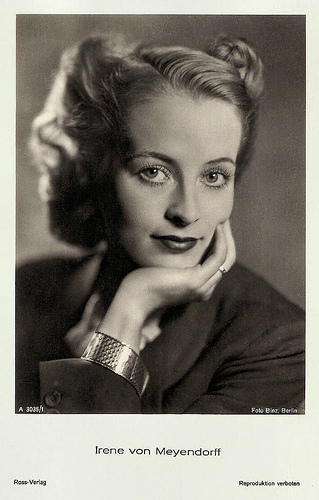
German postcard by Ross-Verlag, no. A 3035/1, 1941-1944. Photo: Binz, Berlin.
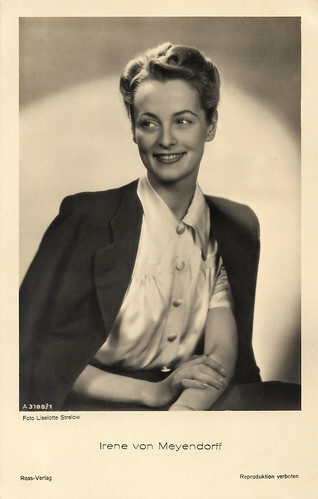
German postcard by Ross Verlag, no. A 3108/1, 1941-1944. Photo: Liselotte Strelow.
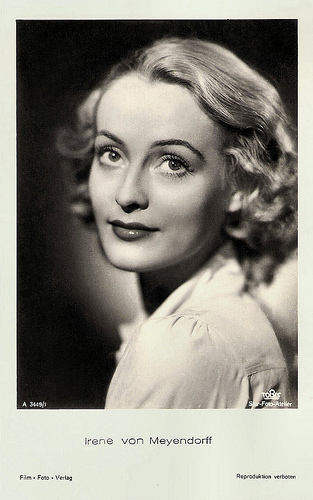
German postcard by Film-Foto-Verlag, no. A 3449/1, 1941-1944. Photo: Tobis / Star-Foto-Atelier.
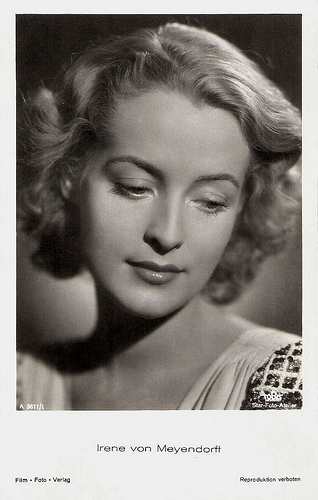
German postcard by Film-Foto-Verlag, no. A 3611/1, 1941-1944. Photo: Tobis / Star Foto Atelier.
Irina
In 1960, Irene von Meyendorff met British actor James Robertson Justice on the set of Die Botschafterin/The Ambassadress (Harald Braun, 1960). The couple fell passionately in love. She left her third husband, journalist Pit Severin, to follow Robertson Justice to England. (Her second husband had been film producer Joachim Matthes). Incidentally, she appeared in German films like Lange Beine - lange Finger/Long Legs, Long Fingers (Alfred Vohrer, 1966) starring Senta Berger .
She became a British citizen in 1967 and changed her name to Irina. She did small parts in international films with her husband, such as the crime film Hell is Empty (John Ainsworth, Bernard Knowles, 1967) starring Martine Carol in her last role, and the costume drama Mayerling (Terence Young, 1968) with Omar Sharif and Catherine Deneuve . Her last film was the Italian production Il gesto/The Gesture (Marcello Grottesi, 1973) with Ilse Steppat and Willy Birgel .
A series of strokes gradually prevented James Robertson Justice from working and led to his bankruptcy. Earning her living as a teacher at a local Language School, Irina nursed him until he died in 1975. After 14 years of living together, they were finally married on his deathbed in the hospital.
In 1990, she married his best friend and their neighbour, the millionaire and philanthropist Keith ‘Toby’ Bromley. She was a passionate gardener and excellent cook; her rose garden at Ashley Manor - the home she and Keith Bromley shared - was renowned locally, as was her extensive hospitality. Even at the age of 70, she sailed to the Arctic and the Orinoco River. For her long and acclaimed work in the German cinema, she was awarded the Filmband in Gold in 1988.
In 2001, Irene von Meyendorff died of natural causes in King's Somborne, Hampshire, UK, after a full, remarkable life. She had one son, Andreas Zahler, who died in 1985. She had two grandchildren, Rebecca, daughter of Andreas Zahler, and a son from his first marriage.
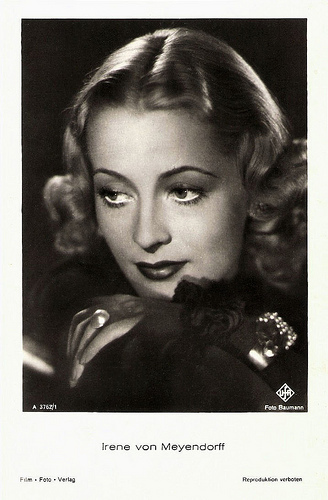
German postcard by Film-Foto-Verlag, no. A 3762/1, 1941-1944. Photo: Ufa / Foto Baumann.
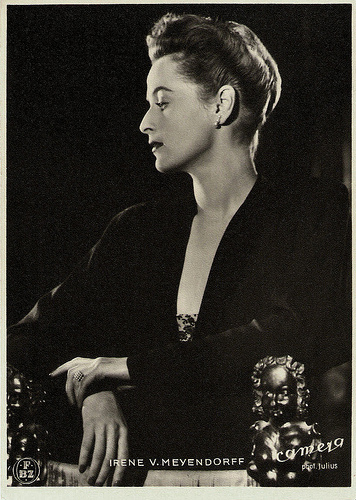
Vintage postcard in the Camera series by F.B.Z. Photo: Julius.
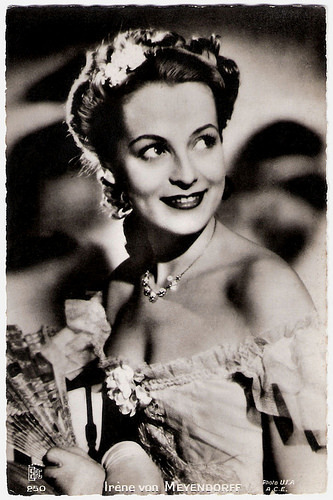
French postcard by EPC (Editions et Publications Cinematographoques), no. 250. Photo: Ufa / A.C.E.
Sources: Hal Erickson (AllMovie - Page now defunct), Thomas Staedeli (Cyranos), (IMDb), Wikipedia (German) and .

German postcard by Film-Foto-Verlag, no. G 201, 1941-1944. Photo: Foto Baumann.

German postcard by Film-Foto-Verlag, no. A 3836/1, 1941-1944. Photo: Baumann. / Ufa. From Tatiana.

Big German postcard by Film-Foto-Verlag, no. K 1430. Photo: Baumann / Ufa.
The horny goat of Babelsberg
Irene von Meyendorff was born as Irene Isabella Margarethe Paulina Caecilia Freiin von Meyendorff in Reval, Russian Empire (now Tallinn, Estonia) in 1916. She was the eldest child of a German-Baltic aristocrat. After the October Revolution, the family fled to Bremen in Germany. There Irene's mother Elisabeth left her conservative husband with the children to live an unconventional life in the theatre circles of Weimar/Thuringia.
In the early 1930s, Irene went to Berlin to work as a cutter in the Ufa film studios of Babelsberg. Breathtakingly beautiful, she was soon discovered for the screen. Her debut was a mediocre Swashbuckler, Die letzten Vier von Santa Cruz/The Last Four of Santa Cruz (Werner Klingler, 1936), which unexpectedly made her a star.
She then appeared with Lída Baarová in Verräter/The Traitor (Karl Ritter, 1936), and with Hans Albers and Françoise Rosay in the circus film Fahrendes Volk/People Who Travel (Jacques Feyder, 1938). Von Meyendorff starred opposite Erich Ponto in Schneider Wibbel/Tailor Wibbel ( Viktor de Kowa , 1939) based on a script by Helmut Käutner , and she appeared opposite Hans Moser in the comedy Einmal der liebe Herrgott sein/To Be God For Once (Hans H. Zerlett, 1942). She also starred in operetta films such as Frau Luna/Lady Luna ( Theo Lingen , 1943) with Lizzi Waldmüller .
Maybe her best part during this period was the noble Hamburg Patrician daughter Octavia in Veit Harlan 's Opfergang/The Great Sacrifice (1944) with Carl Raddatz and Kristina Söderbaum . She also appeared in Harlan’s Propaganda film Kolberg/Burning Hearts (Veit Harlan, 1945) starring Söderbaum and Heinrich George . This film was the pride and joy of the Nazi propaganda machine. It was filmed during the last year of the war. Lavish financial and material resources were expended to produce the film, and it premiered just ahead of the advancing Allied armies.
Von Meyendorff never was a sympathiser of the Nazi system though. Her first husband, Dr. Heinz Zahler, was a member of the Kreisau Circle, a group of religiously motivated anti-Nazi-bourgeois. Her beauty attracted Josef Goebbels, minister of propaganda, who got a harsh rebuff from her ("You would degrade me - and you would degrade yourself"), according to her own recollections. Reportedly, Goebbels's nasty nick name ‘Bock von Babelsberg' (Horny Goat of Babelsberg) was Irene's creation.

German postcard by Ross Verlag, no. A 2133/1, 1939-1940. Photo: Haenchen / Tobis.

German postcard by Ross Verlag, no. A 2207/2, 1939-1940. Photo: Quick / Tobis.

German postcard by Ross Verlag, no. A 2592/1, 1939-1940. Photo: Quick / Tobis.

German postcard by Ross Verlag, no. A 2751/1, 1939-1940. Photo: Quick / Tobis.
A modern Adam and Eve
Between 1946 and 1949, some German films showed the will not to just simply go on like nothing happened but to search for new forms of entertainment in the light of the Second World War and the guilt of the German people. Irene von Meyendorff starred in one of these films, Film ohne Titel/Film Without a Title (Rudolf Jugert, 1948) with Hans Söhnker and Hildegard Knef .
Reviewer Herbert Schwaab writes at IMDb that the film is an "interesting reflection about the rights to be entertained: Which stories can be told, when all stories seem to have been finished? It shows the attempts of a film crew to shoot a film. They offer several versions of one simple love story in different film forms (melodrama or German expressionism) until they come out with the right form (which is this film itself)."
That same year, she was also seen in the Biopic The Mozart Story (Karl Hartl, Frank Wisbar, 1948) featuring Hans Holt . This was an Austrian film that was begun by Karl Hartl before World War II, but was shelved, unfinished, when the war began. After the war, the American rights to the film were purchased by Screen Guild. American-German director Frank Wisbar supervised the English dubbing and even added some new scenes, with Wilton Graff as Mozart's great rival, Antonio Salieri. The result was released as a new film, when it was actually at least 10 years old. Hal Erickson at AllMovie comments: “Despite its patchwork construction, The Mozart Story weaves a cogent and credible (if not altogether accurate) version of Mozart's life and work.”
Another interesting film was Der Apfel ist Ab/The Original Sin (Helmut Käutner, 1948), a fantasy about a modern Adam and Eve. The next year she played the lead role in the comedy Einmaleins der Ehe/1 x 1 of the Marriage (Rudolf Jugert, 1949) opposite Hans Söhnker and in 1950 she co-starred in Epilog: Das Geheimnis der Orplid/Epilogue (Helmut Käutner, 1950) a suspenseful drama about people on board of a boat.
In 1953, she starred in the crime film Gift im Zoo/Poison in the Zoo (Hans Müller, 1953) with Carl Raddatz . She again worked with Helmut Käutner in the romance Bildnis einer Unbekannten/Portrait of an Unknown Woman (Helmut Käutner, 1954) starring Ruth Leuwerik and O.W. Fischer. During the second half of the 1950s, her roles became less frequent and her films less interesting. She focused more on her stage career and played in theatres in Stuttgart, Zurich, Frankfurt am Main and Hamburg.

German postcard by Ross-Verlag, no. A 3035/1, 1941-1944. Photo: Binz, Berlin.

German postcard by Ross Verlag, no. A 3108/1, 1941-1944. Photo: Liselotte Strelow.

German postcard by Film-Foto-Verlag, no. A 3449/1, 1941-1944. Photo: Tobis / Star-Foto-Atelier.

German postcard by Film-Foto-Verlag, no. A 3611/1, 1941-1944. Photo: Tobis / Star Foto Atelier.
Irina
In 1960, Irene von Meyendorff met British actor James Robertson Justice on the set of Die Botschafterin/The Ambassadress (Harald Braun, 1960). The couple fell passionately in love. She left her third husband, journalist Pit Severin, to follow Robertson Justice to England. (Her second husband had been film producer Joachim Matthes). Incidentally, she appeared in German films like Lange Beine - lange Finger/Long Legs, Long Fingers (Alfred Vohrer, 1966) starring Senta Berger .
She became a British citizen in 1967 and changed her name to Irina. She did small parts in international films with her husband, such as the crime film Hell is Empty (John Ainsworth, Bernard Knowles, 1967) starring Martine Carol in her last role, and the costume drama Mayerling (Terence Young, 1968) with Omar Sharif and Catherine Deneuve . Her last film was the Italian production Il gesto/The Gesture (Marcello Grottesi, 1973) with Ilse Steppat and Willy Birgel .
A series of strokes gradually prevented James Robertson Justice from working and led to his bankruptcy. Earning her living as a teacher at a local Language School, Irina nursed him until he died in 1975. After 14 years of living together, they were finally married on his deathbed in the hospital.
In 1990, she married his best friend and their neighbour, the millionaire and philanthropist Keith ‘Toby’ Bromley. She was a passionate gardener and excellent cook; her rose garden at Ashley Manor - the home she and Keith Bromley shared - was renowned locally, as was her extensive hospitality. Even at the age of 70, she sailed to the Arctic and the Orinoco River. For her long and acclaimed work in the German cinema, she was awarded the Filmband in Gold in 1988.
In 2001, Irene von Meyendorff died of natural causes in King's Somborne, Hampshire, UK, after a full, remarkable life. She had one son, Andreas Zahler, who died in 1985. She had two grandchildren, Rebecca, daughter of Andreas Zahler, and a son from his first marriage.

German postcard by Film-Foto-Verlag, no. A 3762/1, 1941-1944. Photo: Ufa / Foto Baumann.

Vintage postcard in the Camera series by F.B.Z. Photo: Julius.

French postcard by EPC (Editions et Publications Cinematographoques), no. 250. Photo: Ufa / A.C.E.
Sources: Hal Erickson (AllMovie - Page now defunct), Thomas Staedeli (Cyranos), (IMDb), Wikipedia (German) and .
Published on July 25, 2025 22:00
July 24, 2025
Louis Calhern
Tall, distinguished, aristocratic Louis Calhern (1895-1956) was a very versatile actor. He was as much at home playing a comic foil to The Marx Brothers in Duck Soup (1933) as he was as Buffalo Bill to Betty Hutton's Annie Oakley in Annie Get Your Gun (1950) or, most memorably, the lawyer involved with a criminal gang and Marilyn Monroe's sugardaddy in The Asphalt Jungle (1950).
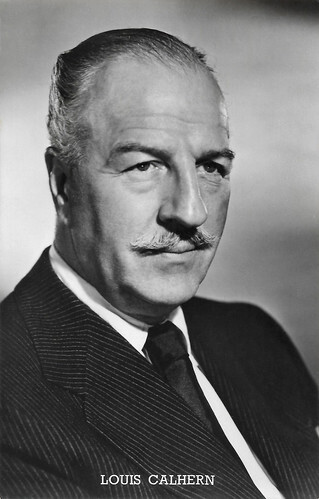
Vintage postcard, no. 61. Photo: M.G.M.
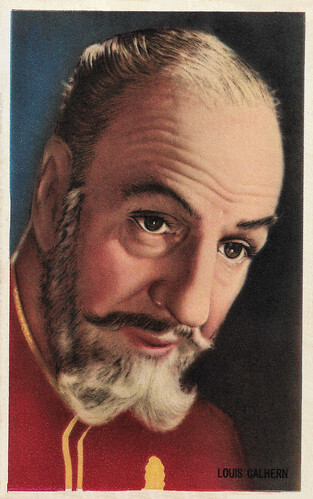
Belgian collector card by Kwatta, Bois d'Haine, no. C. 231. Photo: M.G.M. Louis Calhern in Arch of Triumph (Lewis Milestone, 1948).
A wide range of aristocratic, paternal, emotionally cold, tragic and comedic characters
Louis Calhern was born Carl Henry Vogt in Brooklyn, New York, in 1895. His parents, Eugene Adolf and Hubertina (Friese) Vogt, had migrated to New York from Germany. The family moved to Saint Louis, Missouri, where he grew up. His career in the professional theatre began when he was seventeen and a player on his high school's football team. Grace George's travelling Shakespeare repertory company came to St. Louis to present 'Much Ado About Nothing' and hired the football team to appear as extras in the show. Right then and there, the theatre bug hit him good and proper.
During the First World War, he began training as an actor in New York. Due to the anti-German sentiment during World War I, he adopted a pseudonym for his German name. His stage name is an amalgamation of his hometown of St Louis and his first and middle names, Carl and Henry (Calhern). Louis Calhern celebrated his first major success on Broadway in New York in 1923.
Numerous stage successes were to follow there, including as King Lear after William Shakespeare , as the colonel in Franz Werfel's 'Jakobowsky and the Colonel' and in the role of the American U.S. Supreme Court Justice Oliver Wendell Holmes in 'The Magnificent Yankee'.He not only played Holmes for a long time on stage, but also in the 1950 film version, for which he received an Oscar nomination.
In 1921, Louis Calhern appeared in three silent films, all co-starring Claire Windsor and all directed and written by female film pioneer Lois Weber: What's Worth While?, Too Wise Wives, and The Blot. In 1923, Calhern left the cinema, deciding to devote his career entirely to the stage.
With the advent of the sound film, he returned and played a wide range of aristocratic, paternal, emotionally cold, tragic and comedic characters. Calhern played Ambassador Trentino of Sylvania in the Marx Brothers comedy Duck Soup (Leo McCarey, 1933). He also acted with the comedy duo Robert Woolsey and Bert Wheeler in Diplomaniacs (William A. Seiter, 1933). He played in such thrillers as 20. 000 Years in Sing Sing (Michael Curtiz, 1932) as a mobster alongside Spencer Tracy and Bette Davis , and historical dramas such as The Last Days of Pompeii (Merian C. Cooper, Ernest B. Schoedsack, 1935). He played the unscrupulous prosecutor Villefort alongside Robert Donat in the Alexandre Dumas adaptation The Count of Monte Cristo (Rowland V. Lee, 1934), and he was Major Dort in The Life of Emile Zola (William Dieterle, 1937), starring Paul Muni . The film won the Oscar for Best Picture.
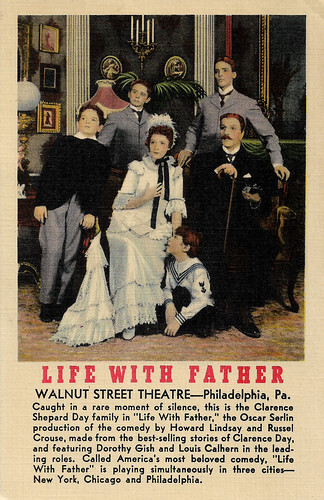
American postcard by Tichnor Bros Inc., Boston, Mass, no. 68686. Dorothy Gish and Louis Calhern in the stage production 'Life With Father' at the Walnut Street Theatre, Philadelphia, Pa.
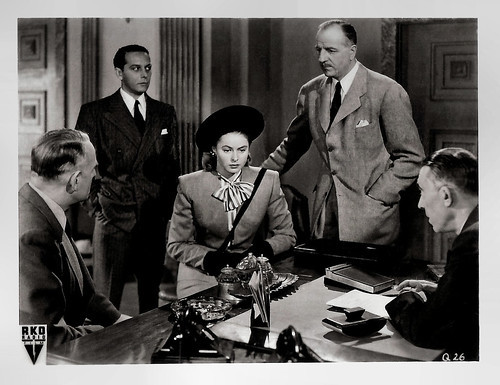
German collector card. Photo: RKO Radio Film. Ingrid Bergman and Louis Calhern in Notorious (Alfred Hitchcock, 1946).
A late career peak in MGM productions
In 1940, Louis Calhern left Hollywood for two and a half years. Returning to the east, he joined the touring company of the tremendous stage hit, 'Life With Father', starring opposite Dorothy Gish . The show set a modern record in Boston by running there for twenty-two consecutive weeks. Calhern continued to tour with the play for two years and even replaced Howard Lindsay of the original New York cast for six weeks in the fall of 1942.
Back in Hollywood, he played the somewhat stiff father of Don Ameche in Ernst Lubitsch 's classic comedy Heaven Can Wait (1943). After the war, Calhern played the head of the US Secret Service in Hitchcock's spy drama Notorious (Alfred Hitchcock, 1946), starring Ingrid Bergman . He also appeared with Bergman in the drama Arch of Triumph (Lewis Milestone, 1948). In 1949, Calhern replaced actor Frank Morgan, who died of a heart attack while filming Annie Get Your Gun.
In 1950, he experienced a late career peak in MGM productions. In addition to his Oscar-nominated role of Oliver Wendell Holmes in The Magnificent Yankee (John Sturges, 1950), he also played the ageing Buffalo Bill in the film version of the musical Annie Get Your Gun (George Sidney, 1950) and Marilyn Monroe 's fatherly friend and head of a gang of criminals in The Asphalt Jungle (John Huston, 1950). In 1950, Calhern also undertook the extremely challenging title role in John Houseman's stage production of William Shakespeare 's 'King Lear.' Supported by Nina Foch and Jo Van Fleet, he was universally lauded for his portrayal. Two years later, he played alongside Marilyn Monroe once again in the romantic comedy We're Not Married (Edmund Goulding, 1952). This was followed by roles in the adventure films The Prisoner of Zenda (Richard Thorpe, 1952) alongside Stewart Granger and as Baal Priest alongside Lana Turner in The Prodigal (Richard Thorpe, 1955).
Calhern won a Special Jury Prize at the 15th Venice International Film Festival for his performance in Executive Suite (Robert Wise, 1954). The film, which took a look behind the closed doors of a corporation in crisis, featured such luminaries as William Holden , Fredric March , and Barbara Stanwyck . He played the title role in Julius Caesar (Joseph L. Mankiewicz, 1955) opposite Marlon Brando as Marc Antony. He acted alongside Clark Gable in the war drama Betrayed (Gottfried Reinhardt, 1954) and played a cynical teacher in the drama Blackboard Jungle (Richard Brooks, 1955). He also performed in the film musicals Rhapsody (Charles Vidor, 1954), with Elizabeth Taylor , and High Society (Charles Walters, 1955) as Grace Kelly 's cheerfully lecherous Uncle Willie.
Louis Calhern battled alcohol addiction for much of his adult life. As a result, he missed out on several cinema and stage roles. He finally overcame his alcohol addiction towards the end of the 1940s. In 1956, Calhern died of a heart attack at the age of 61 in Nara, Japan, when he starred in the film The Teahouse of the August Moon (Daniel Mann, 1956) with Glenn Ford and Marlon Brando . Calhern's part as Colonel Wainwright Purdy III was taken over by Paul Ford. His body was cremated and interred at Hollywood Forever Cemetery in Los Angeles, California. Calhern married and divorced four actresses. From 1926 to 1927, he was married to Ilka Chase. From 1927 to 1932 to Julia Hoyt, from 1933 to 1942 to Natalie Schafer and from 1946 to 1955 to Marianne Stewart, the daughter of Reinhold Schünzel. Ken Dennis at Films of the Golden Age: "With his amazing versatility, he played witty raconteurs, lecherous sugar daddies, dastardly villains, double-dealing lawyers, and such historical figures as Julius Caesar, Oliver Wendell Holmes, and Buffalo Bill Cody with equal skill. Despite a frequently turbulent domestic life and a long battle with alcoholism, Louis Calhern was the complete professional and every inch the distinguished gentleman."
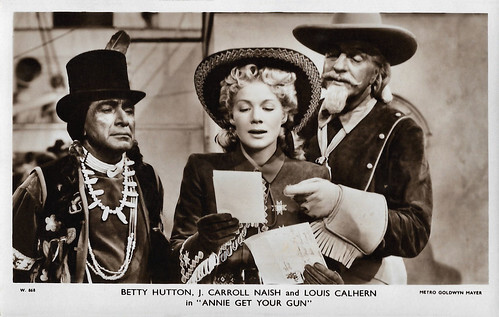
British postcard in the Picturegoer series, London, no. W. 868. Photo: Metro Goldwyn Mayer. Betty Hutton , J. Carrol Naish and Louis Calhern in Annie Get Your Gun (George Sidney, 1950).

British postcard on the Picturegoer Series, London, no. D 252. Photo: Metro-Goldwyn-Mayer. Stewart Granger , Louis Calhern and Deborah Kerr in The Prisoner of Zenda (Richard Thorpe, 1952).
Sources: Ken Dennis (Films of the Golden Age), Wikipedia (Dutch, German and English) and .

Vintage postcard, no. 61. Photo: M.G.M.

Belgian collector card by Kwatta, Bois d'Haine, no. C. 231. Photo: M.G.M. Louis Calhern in Arch of Triumph (Lewis Milestone, 1948).
A wide range of aristocratic, paternal, emotionally cold, tragic and comedic characters
Louis Calhern was born Carl Henry Vogt in Brooklyn, New York, in 1895. His parents, Eugene Adolf and Hubertina (Friese) Vogt, had migrated to New York from Germany. The family moved to Saint Louis, Missouri, where he grew up. His career in the professional theatre began when he was seventeen and a player on his high school's football team. Grace George's travelling Shakespeare repertory company came to St. Louis to present 'Much Ado About Nothing' and hired the football team to appear as extras in the show. Right then and there, the theatre bug hit him good and proper.
During the First World War, he began training as an actor in New York. Due to the anti-German sentiment during World War I, he adopted a pseudonym for his German name. His stage name is an amalgamation of his hometown of St Louis and his first and middle names, Carl and Henry (Calhern). Louis Calhern celebrated his first major success on Broadway in New York in 1923.
Numerous stage successes were to follow there, including as King Lear after William Shakespeare , as the colonel in Franz Werfel's 'Jakobowsky and the Colonel' and in the role of the American U.S. Supreme Court Justice Oliver Wendell Holmes in 'The Magnificent Yankee'.He not only played Holmes for a long time on stage, but also in the 1950 film version, for which he received an Oscar nomination.
In 1921, Louis Calhern appeared in three silent films, all co-starring Claire Windsor and all directed and written by female film pioneer Lois Weber: What's Worth While?, Too Wise Wives, and The Blot. In 1923, Calhern left the cinema, deciding to devote his career entirely to the stage.
With the advent of the sound film, he returned and played a wide range of aristocratic, paternal, emotionally cold, tragic and comedic characters. Calhern played Ambassador Trentino of Sylvania in the Marx Brothers comedy Duck Soup (Leo McCarey, 1933). He also acted with the comedy duo Robert Woolsey and Bert Wheeler in Diplomaniacs (William A. Seiter, 1933). He played in such thrillers as 20. 000 Years in Sing Sing (Michael Curtiz, 1932) as a mobster alongside Spencer Tracy and Bette Davis , and historical dramas such as The Last Days of Pompeii (Merian C. Cooper, Ernest B. Schoedsack, 1935). He played the unscrupulous prosecutor Villefort alongside Robert Donat in the Alexandre Dumas adaptation The Count of Monte Cristo (Rowland V. Lee, 1934), and he was Major Dort in The Life of Emile Zola (William Dieterle, 1937), starring Paul Muni . The film won the Oscar for Best Picture.

American postcard by Tichnor Bros Inc., Boston, Mass, no. 68686. Dorothy Gish and Louis Calhern in the stage production 'Life With Father' at the Walnut Street Theatre, Philadelphia, Pa.

German collector card. Photo: RKO Radio Film. Ingrid Bergman and Louis Calhern in Notorious (Alfred Hitchcock, 1946).
A late career peak in MGM productions
In 1940, Louis Calhern left Hollywood for two and a half years. Returning to the east, he joined the touring company of the tremendous stage hit, 'Life With Father', starring opposite Dorothy Gish . The show set a modern record in Boston by running there for twenty-two consecutive weeks. Calhern continued to tour with the play for two years and even replaced Howard Lindsay of the original New York cast for six weeks in the fall of 1942.
Back in Hollywood, he played the somewhat stiff father of Don Ameche in Ernst Lubitsch 's classic comedy Heaven Can Wait (1943). After the war, Calhern played the head of the US Secret Service in Hitchcock's spy drama Notorious (Alfred Hitchcock, 1946), starring Ingrid Bergman . He also appeared with Bergman in the drama Arch of Triumph (Lewis Milestone, 1948). In 1949, Calhern replaced actor Frank Morgan, who died of a heart attack while filming Annie Get Your Gun.
In 1950, he experienced a late career peak in MGM productions. In addition to his Oscar-nominated role of Oliver Wendell Holmes in The Magnificent Yankee (John Sturges, 1950), he also played the ageing Buffalo Bill in the film version of the musical Annie Get Your Gun (George Sidney, 1950) and Marilyn Monroe 's fatherly friend and head of a gang of criminals in The Asphalt Jungle (John Huston, 1950). In 1950, Calhern also undertook the extremely challenging title role in John Houseman's stage production of William Shakespeare 's 'King Lear.' Supported by Nina Foch and Jo Van Fleet, he was universally lauded for his portrayal. Two years later, he played alongside Marilyn Monroe once again in the romantic comedy We're Not Married (Edmund Goulding, 1952). This was followed by roles in the adventure films The Prisoner of Zenda (Richard Thorpe, 1952) alongside Stewart Granger and as Baal Priest alongside Lana Turner in The Prodigal (Richard Thorpe, 1955).
Calhern won a Special Jury Prize at the 15th Venice International Film Festival for his performance in Executive Suite (Robert Wise, 1954). The film, which took a look behind the closed doors of a corporation in crisis, featured such luminaries as William Holden , Fredric March , and Barbara Stanwyck . He played the title role in Julius Caesar (Joseph L. Mankiewicz, 1955) opposite Marlon Brando as Marc Antony. He acted alongside Clark Gable in the war drama Betrayed (Gottfried Reinhardt, 1954) and played a cynical teacher in the drama Blackboard Jungle (Richard Brooks, 1955). He also performed in the film musicals Rhapsody (Charles Vidor, 1954), with Elizabeth Taylor , and High Society (Charles Walters, 1955) as Grace Kelly 's cheerfully lecherous Uncle Willie.
Louis Calhern battled alcohol addiction for much of his adult life. As a result, he missed out on several cinema and stage roles. He finally overcame his alcohol addiction towards the end of the 1940s. In 1956, Calhern died of a heart attack at the age of 61 in Nara, Japan, when he starred in the film The Teahouse of the August Moon (Daniel Mann, 1956) with Glenn Ford and Marlon Brando . Calhern's part as Colonel Wainwright Purdy III was taken over by Paul Ford. His body was cremated and interred at Hollywood Forever Cemetery in Los Angeles, California. Calhern married and divorced four actresses. From 1926 to 1927, he was married to Ilka Chase. From 1927 to 1932 to Julia Hoyt, from 1933 to 1942 to Natalie Schafer and from 1946 to 1955 to Marianne Stewart, the daughter of Reinhold Schünzel. Ken Dennis at Films of the Golden Age: "With his amazing versatility, he played witty raconteurs, lecherous sugar daddies, dastardly villains, double-dealing lawyers, and such historical figures as Julius Caesar, Oliver Wendell Holmes, and Buffalo Bill Cody with equal skill. Despite a frequently turbulent domestic life and a long battle with alcoholism, Louis Calhern was the complete professional and every inch the distinguished gentleman."

British postcard in the Picturegoer series, London, no. W. 868. Photo: Metro Goldwyn Mayer. Betty Hutton , J. Carrol Naish and Louis Calhern in Annie Get Your Gun (George Sidney, 1950).

British postcard on the Picturegoer Series, London, no. D 252. Photo: Metro-Goldwyn-Mayer. Stewart Granger , Louis Calhern and Deborah Kerr in The Prisoner of Zenda (Richard Thorpe, 1952).
Sources: Ken Dennis (Films of the Golden Age), Wikipedia (Dutch, German and English) and .
Published on July 24, 2025 22:00
July 23, 2025
Ariadna Shengelaya
Soviet and Russian theatre and film actress Ariadna Shengelaya (1937) was one of the most popular stars in Soviet cinema in the late 1950s and early 1960s. The beautiful actress portrayed many aristocratic figures in literary adaptations, such as Tatyana Larina in Yevgeni Onegin / Eugene Onegin (1959) and Eugénie Grandet in Eugénie Grandet (1960). She was married to the Georgian film director Eldar Shengelaya from 1957 to 1980 and appeared in 33 films between 1957 and 1997.
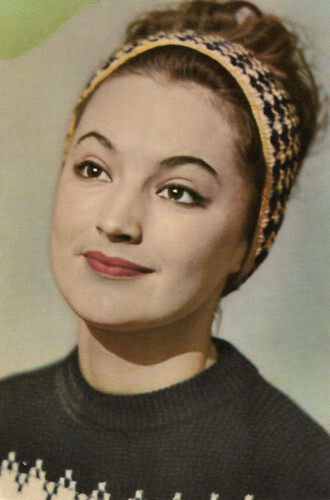
Soviet postcard, no. A 11254, 1966. Photo: G. Vajpja.
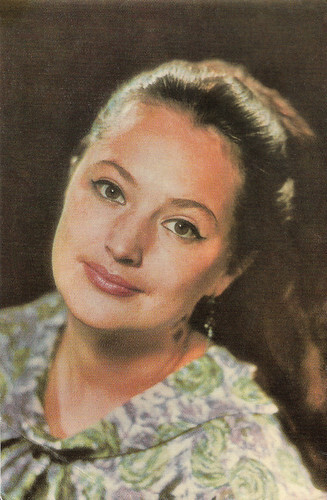
Soviet postcard, no. A 07692, 1969.
Joining an illustrious family of Georgian filmmakers
Ariadna Vsevolodovna Shengelaya née Sprinck (Russian: Ариа́дна Все́володовна Шенгела́я) was born in Tashkent on in 1937. Her father, Vsevolod E. Sprinck, was a German-born scientist, economist, and translator who spent a significant amount of time in Stalin's labour camps.
In 1960, Ariadna completed her studies at the All-Union State Institute of Cinematography (VGIK) in Vladimir Belokurov's class. During her studies, Ariadna made her film acting debut in the romantic drama Ekaterina Voronina (Isidor Annensky, 1956) as Irina. The film was watched by 27.8 million Soviet viewers. She appeared in two other films while still a student at the Institute of Cinematography: the Opera film Yevgeni Onegin / Eugene Onegin (Roman Tikhomirov, 1959) and Evgeniya Grande / Eugenia Grande (Sergei Alekseyev, 1960). For Yevgeni Onegin, Ariadna won the II All-Union Film Festival's Award for 'Best Actor' in 1959. The film is a screen version of the famous 1879 opera 'Eugene Onegin' by Pyotr Tchaikovsky, based on the 1825-1832 novel in verse by Alexander Pushkin. Her role was sung by Galina Vishnevskaya.
Her delicate, aristocratic beauty and her old Greek name, Ariadne, were liked by the audience. She appeared in such intriguing films as the Fyodor Dostoevsky adaptation Belye nochi / White Nights (Ivan Pyriev, 1959), starring Oleg Strizhenov , the musical comedy Ostorozhno, babushka! / Be Careful, Grandma! (Nadezhda Kosheverova, 1960) opposite Faina Ranevskaya, and the romantic drama Granatovyy braslet / The Garnet Bracelet (Abram Room, 1964). For her performance in The Garnet Bracelet, she was selected Best Actress in a 1965 poll by the publication 'Soviet Screen'.
On stage, Ariadna Shengelaya played the roles of Anne Frank in 'Anne Frank's Diary' by E. Goodrich and A. Heckett and Cleopatra in 'Caesar and Cleopatra' by George Bernard Shaw. Ariadna joined the troupe of the Griboedov Russian Dramatic Theatre in Tbilisi, in the Georgian Soviet Socialist Republic, and worked for the Grouzia-film production studios. She married director Eldar Shengelaya and changed her last name from Sprinck to Shengelaya.
Her husband directed her in such films as the romantic drama Belyy karavan / The White Caravan (Tamaz Meliava, Eldar Shengelaya, 1963), which was entered into the 1964 Cannes Film Festival, and the masterpiece Sherekilebi / The Eccentrics (Eldar Shengelaya, 1974). By her marriage, she joined an illustrious family of Georgian filmmakers. Her mother-in-law, actress Nato Vachnadze, was one of the biggest names in Georgian cinema, who tragically perished in an aeroplane disaster. Her father-in-law, Nikolai Shengelaya, was a well-known film director. Their sons, Eldar and Georgy, also achieved success as filmmakers and won numerous significant international accolades. Georgy wed the well-known actress Sofiko Chiaureli. Ariadna and Eldar had two daughters: actress Natalia 'Nato' Shengelaya (1958) and Ekaterina Shengelaya (1967).
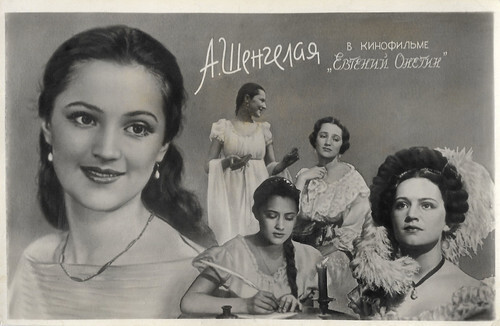
Soviet postcard. Ariadna Shengelaia in Yevgeni Onegin / Eugene Onegin (Roman Tikhomirov, 1959).
Co-productions with Hungary, East Germany, India and China
Ariadna Shengelaya appeared in many Georgian films, including the classic comedy-drama Ne goryuy! / Don't Cry! (Georgiy Daneliya, 1968). In Hungary, she played in the Hungarian-Soviet epic musical-drama Szerelmi álmok – Liszt / Dreams of Love – Liszt (Márton Keleti, 1970) based on the biography of the Hungarian composer and pianist Franz Liszt.
In East Germany, she appeared in the drama Goya – oder der arge Weg der Erkenntnis / Goya or the Hard Way to Enlightenment (Konrad Wolf, 1971), starring Donatas Banionis as painter Francisco Goya. The film, based on a novel by Lion Feuchtwanger, was entered into the 7th Moscow International Film Festival, where it won a Special Prize.
In 1980, Ariadna Shengelaya and her husband divorced, and that year, she became a member of the cast of the Gorki Film Studio. She appeared in the family film Uchenik lekarya / The Doctor's Pupil (Boris Rytsarev, 1984) and the drama V Krymu ne vsegda leto / Not Every Year in Crimea (Villen Novak, 1988).
Shengelaya played the role of the Queen Mother in the Indian-Russian coproduction Ajooba / Черный принц Аджуб / Wonder (1991) starring Amitabh Bachchan as the Prince of the Kingdom of Baharistan. The film was produced and directed by Shashi Kapoor and also co-directed by the Soviet filmmaker Gennadi Vasilyev. The Superhero film was loosely based on Arabic folklore, such as 'One Thousand and One Nights'. It was the last successful collaboration between the Indian and Soviet film industries.
She also appeared in a Chinese-Russian coproduction, the fairytale Volshebnyy portret /The Magical Portrait (Gennadiy Vasilev, 1997). Her final screen appearance was in the TV film Babi Yar (Lyudmila Shtogarenko, Nikolay Zaseev-Rudenko, 2002) with Elina Bystritskaya . Ariadna Shengelaya was designated a People's Artist of Russia and the Georgian SSR in 1979, respectively (2000). Her second husband, actor Igor Koptchenko, died in 2003.
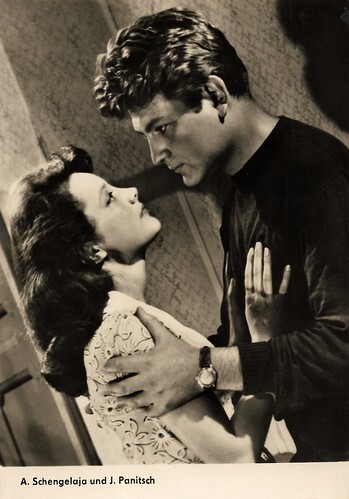
East German postcard by VEB Progress Film-Vertrieb, Berlin, no. 1641, 1961. Ariadna Shengelaya and Yulian Panich in Ostorozhno, babushka! / Be Careful, Grandma! (Nadezhda Kosheverova, 1961).
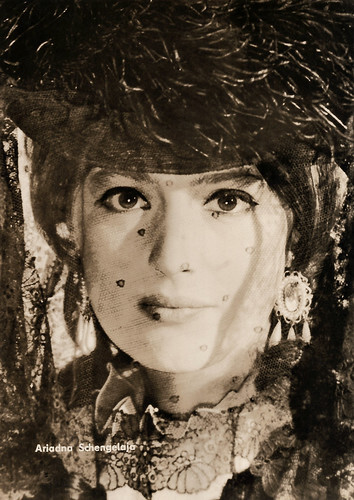
East German postcard by VEB Progress Film-Vertrieb, Berlin, no. 145/71. Ariadna Shengelaya in Szerelmi álmok – Liszt / Dreams of Love – Liszt (Márton Keleti, 1970).
Sources: Wikipedia and .

Soviet postcard, no. A 11254, 1966. Photo: G. Vajpja.

Soviet postcard, no. A 07692, 1969.
Joining an illustrious family of Georgian filmmakers
Ariadna Vsevolodovna Shengelaya née Sprinck (Russian: Ариа́дна Все́володовна Шенгела́я) was born in Tashkent on in 1937. Her father, Vsevolod E. Sprinck, was a German-born scientist, economist, and translator who spent a significant amount of time in Stalin's labour camps.
In 1960, Ariadna completed her studies at the All-Union State Institute of Cinematography (VGIK) in Vladimir Belokurov's class. During her studies, Ariadna made her film acting debut in the romantic drama Ekaterina Voronina (Isidor Annensky, 1956) as Irina. The film was watched by 27.8 million Soviet viewers. She appeared in two other films while still a student at the Institute of Cinematography: the Opera film Yevgeni Onegin / Eugene Onegin (Roman Tikhomirov, 1959) and Evgeniya Grande / Eugenia Grande (Sergei Alekseyev, 1960). For Yevgeni Onegin, Ariadna won the II All-Union Film Festival's Award for 'Best Actor' in 1959. The film is a screen version of the famous 1879 opera 'Eugene Onegin' by Pyotr Tchaikovsky, based on the 1825-1832 novel in verse by Alexander Pushkin. Her role was sung by Galina Vishnevskaya.
Her delicate, aristocratic beauty and her old Greek name, Ariadne, were liked by the audience. She appeared in such intriguing films as the Fyodor Dostoevsky adaptation Belye nochi / White Nights (Ivan Pyriev, 1959), starring Oleg Strizhenov , the musical comedy Ostorozhno, babushka! / Be Careful, Grandma! (Nadezhda Kosheverova, 1960) opposite Faina Ranevskaya, and the romantic drama Granatovyy braslet / The Garnet Bracelet (Abram Room, 1964). For her performance in The Garnet Bracelet, she was selected Best Actress in a 1965 poll by the publication 'Soviet Screen'.
On stage, Ariadna Shengelaya played the roles of Anne Frank in 'Anne Frank's Diary' by E. Goodrich and A. Heckett and Cleopatra in 'Caesar and Cleopatra' by George Bernard Shaw. Ariadna joined the troupe of the Griboedov Russian Dramatic Theatre in Tbilisi, in the Georgian Soviet Socialist Republic, and worked for the Grouzia-film production studios. She married director Eldar Shengelaya and changed her last name from Sprinck to Shengelaya.
Her husband directed her in such films as the romantic drama Belyy karavan / The White Caravan (Tamaz Meliava, Eldar Shengelaya, 1963), which was entered into the 1964 Cannes Film Festival, and the masterpiece Sherekilebi / The Eccentrics (Eldar Shengelaya, 1974). By her marriage, she joined an illustrious family of Georgian filmmakers. Her mother-in-law, actress Nato Vachnadze, was one of the biggest names in Georgian cinema, who tragically perished in an aeroplane disaster. Her father-in-law, Nikolai Shengelaya, was a well-known film director. Their sons, Eldar and Georgy, also achieved success as filmmakers and won numerous significant international accolades. Georgy wed the well-known actress Sofiko Chiaureli. Ariadna and Eldar had two daughters: actress Natalia 'Nato' Shengelaya (1958) and Ekaterina Shengelaya (1967).

Soviet postcard. Ariadna Shengelaia in Yevgeni Onegin / Eugene Onegin (Roman Tikhomirov, 1959).
Co-productions with Hungary, East Germany, India and China
Ariadna Shengelaya appeared in many Georgian films, including the classic comedy-drama Ne goryuy! / Don't Cry! (Georgiy Daneliya, 1968). In Hungary, she played in the Hungarian-Soviet epic musical-drama Szerelmi álmok – Liszt / Dreams of Love – Liszt (Márton Keleti, 1970) based on the biography of the Hungarian composer and pianist Franz Liszt.
In East Germany, she appeared in the drama Goya – oder der arge Weg der Erkenntnis / Goya or the Hard Way to Enlightenment (Konrad Wolf, 1971), starring Donatas Banionis as painter Francisco Goya. The film, based on a novel by Lion Feuchtwanger, was entered into the 7th Moscow International Film Festival, where it won a Special Prize.
In 1980, Ariadna Shengelaya and her husband divorced, and that year, she became a member of the cast of the Gorki Film Studio. She appeared in the family film Uchenik lekarya / The Doctor's Pupil (Boris Rytsarev, 1984) and the drama V Krymu ne vsegda leto / Not Every Year in Crimea (Villen Novak, 1988).
Shengelaya played the role of the Queen Mother in the Indian-Russian coproduction Ajooba / Черный принц Аджуб / Wonder (1991) starring Amitabh Bachchan as the Prince of the Kingdom of Baharistan. The film was produced and directed by Shashi Kapoor and also co-directed by the Soviet filmmaker Gennadi Vasilyev. The Superhero film was loosely based on Arabic folklore, such as 'One Thousand and One Nights'. It was the last successful collaboration between the Indian and Soviet film industries.
She also appeared in a Chinese-Russian coproduction, the fairytale Volshebnyy portret /The Magical Portrait (Gennadiy Vasilev, 1997). Her final screen appearance was in the TV film Babi Yar (Lyudmila Shtogarenko, Nikolay Zaseev-Rudenko, 2002) with Elina Bystritskaya . Ariadna Shengelaya was designated a People's Artist of Russia and the Georgian SSR in 1979, respectively (2000). Her second husband, actor Igor Koptchenko, died in 2003.

East German postcard by VEB Progress Film-Vertrieb, Berlin, no. 1641, 1961. Ariadna Shengelaya and Yulian Panich in Ostorozhno, babushka! / Be Careful, Grandma! (Nadezhda Kosheverova, 1961).

East German postcard by VEB Progress Film-Vertrieb, Berlin, no. 145/71. Ariadna Shengelaya in Szerelmi álmok – Liszt / Dreams of Love – Liszt (Márton Keleti, 1970).
Sources: Wikipedia and .
Published on July 23, 2025 22:00
July 22, 2025
Tim Curry
English actor and singer Tim Curry (1946) starred in more than a hundred films and series. He had his breakthrough as Dr. Frank N. Furter in the Cult film The Rocky Horror Picture Show (1975). He also appeared as Pennywise the Clown in Stephen King's Horror TV miniseries It (1980) and as the butler Wadsworth in the Mystery comedy Clue (1985). In 2004, he created the role of King Arthur in the Monty Python musical 'Spamalot'.
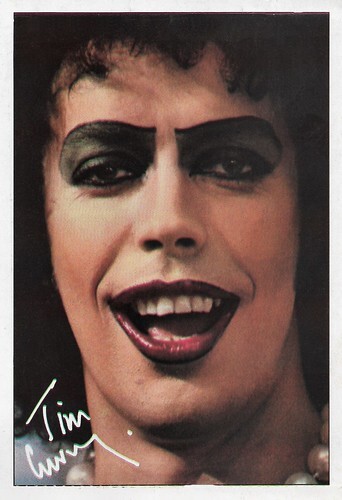
West German autograph card by Bravo, 1980. Tim Curry in The Rocky Horror Picture Show (Jim Sharman, 1975).
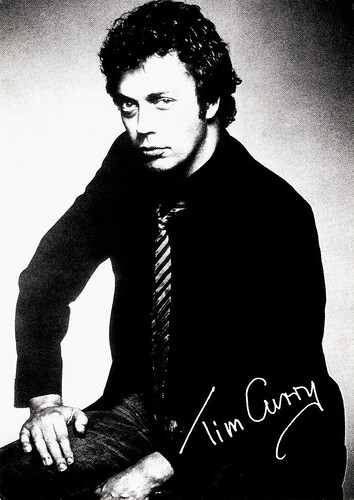
West German autograph card by CBS, The Family of Music, to promote the LPs 'Read My Lips' and 'Fearless'.
A favourite villain through the combination of high eyebrows, plastic smile and exaggerated intonation
Timothy James Curry was born in Grappenhall, Cheshire, in 1946. Curry is the son of school secretary Patricia and Royal Navy chaplain James Curry. His parents were very religious. His elder sister, Judith, later became a concert pianist. Curry spent most of his childhood in Plymouth. Curry developed into a talented boy soprano. His father died of pneumonia in 1958, when Curry was 12 years old. The family moved to South London, where he attended boarding school before attending the prestigious Kingswood School in Bath, Somerset, England, till he was 18.
Deciding to concentrate on acting, he graduated from the University of Birmingham with a combined BA in English and drama in 1968. Curry's first full-time role was as part of the original London cast of the musical 'Hair' in 1968. There he met Richard O'Brien, who went on to write Curry's role of Dr. Frank-N-Furter in the musical 'The Rocky Horror Show' (1973). He played the character as a diabolical mad scientist and transvestite with an upper-class Belgravia accent. The show was an immediate smash hit.
The reviewer of The Guardian wrote that Curry gave a "garishly Bowiesque performance as the ambisextrous doctor." He reprised the role in Los Angeles in 1974 and on Broadway in 1975. His real breakthrough came with the film version, The Rocky Horror Picture Show (Jim Sharman, 1975). It made Curry a household name and gave him a cult following. Curry returned to the stage with Tom Stoppard's 'Travesties', which ran in London and New York from 1975 to 1976. Curry's performance as the famous dadaist Tristan Tzara received good reviews. 'Travesties' was also a Broadway hit, which won two Tony Awards.
Tim Curry began to appear in many films, including the British Horror film The Shout (Jerzy Skolimowski, 1978) starring Alan Bates . In 1978, his first album was released, 'Read My Lips'. He followed this up with 'Fearless' (1979) and 'Simplicity' (1981). After that, Curry focused entirely on his acting career. In 1980, he played Wolfgang Amadeus Mozart in the original Broadway version of 'Amadeus'. Curry was nominated for his first Tony Award (Best Performance by a Leading Actor in a Play) but lost out to his co-star Ian McKellen , who played Antonio Salieri. In 1982, Curry played the Pirate King in Gilbert and Sullivan's 'The Pirates of Penzance' opposite George Cole and Pamela Stephenson.
The combination of high eyebrows, plastic smile and exaggerated intonation in his words made Curry a favourite villain in films and series. He appeared as Johnny LaGuardia in Times Square (Allan Moyle, 1980), as Daniel Francis "Rooster" Hannigan in the film version of Annie (John Huston, 1982), and as Jeremy Hancock in the political film The Ploughman's Lunch (Richard Eyre, 1983). Director Ridley Scott cast Curry as The Lord of Darkness in the Fantasy film Legend (1985) starring Tom Cruise . The same year, Curry appeared in the Mystery comedy Clue (Jonathan Lynn, 1985) as Wadsworth the butler.
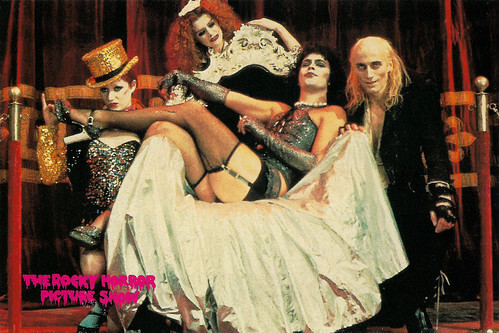
American postcard in the 20th Century Fox Series by the American Postcard Company, no. F21, 1982. Photo: Twentieth Century-Fox. Tim Curry as Dr. Frank-N-Furter (a scientist), Nell Campbell as Little Nell (a groupie), Patricia Quinn as Magenta (a domestic) and Richard O'Brien as Riff Raff (a handyman) in The Rocky Horror Picture Show (Jim Sharman, 1975).
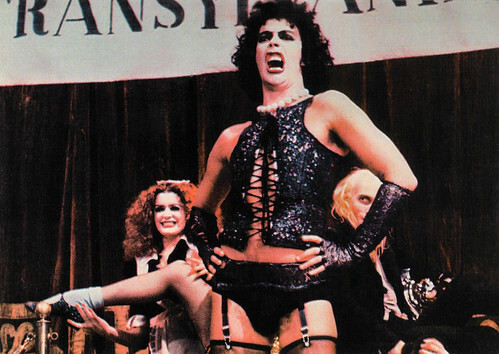
British postcard by Pyramid, Leicester, no. PC 8300. Tim Curry, Patricia Quinn and Richard O'Brien in The Rocky Horror Picture Show (Jim Sharman, 1975).
Pennywise, the child-killing clown
In the mid-1980s, Tim Curry performed in the play 'The Rivals' and with the Royal National Theatre in 'The Threepenny Opera' and other plays. From 1987 to 1988, he toured in the lead role of Bill Snibson in the musical 'Me and My Girl'. After Clue, Curry was cast in more film comedies in the late 1980s and 1990s. He played Mr. Hector the suspicious Plaza Hotel concierge in Home Alone 2: Lost in New York (Chris Columbus, 1992) and Long John Silver in Muppet Treasure Island (Brian Henson, 1996). He also appeared in action films, such as the thriller The Hunt for Red October (John McTiernan, 1990) as Dr. Yevgeniy Petrov, The Three Musketeers (Stephen Herek, 1993) as Cardinal Richelieu, and the superhero film The Shadow (Russell Mulcahy, 1994) as Farley Claymore. In 1992, he played Alan Swann in the Broadway version of 'My Favorite Year', earning him his second Tony Award nomination (Best Performance by a Leading Actor in a Musical).
In the early 1990s, Tim Curry was one of the first well-known Hollywood actors to lend his voice to a character in a computer game. He provided the voice of the main character in parts 1 and 3 of the Gabriel Knight series. Besides Curry, Mark Hamill (best known as Luke Skywalker) and Leah Remini also lent their voices to the series. In 1991, he won a Daytime Emmy Award for his voice role as Captain Hook in the animated series Peter Pan and the Pirates (Nobuo Tomizawa, 1990-1991). He also voiced Hexxus in the film FernGully: The Last Rainforest (Bill Kroyer, 1992), King Chicken in Duckman (Jeff McGrath, a.o., 1994–1997), Sir Nigel Thornberry in The Wild Thornberrys (Cathy Malkasian, a.o., 1998–2004), and Chancellor Palpatine / Darth Sidious in Star Wars: The Clone Wars (Dave Filoni, a.o., 2012–2014).
One of Curry's best-known television roles is as Pennywise the child-killing Clown in the Horror miniseries Stephen King's It (Tommy Lee Wallace, 1990). Although Curry has appeared in numerous television series throughout his career, he has only had lead roles in two live-action series: Over the Top (Michael Lembeck, a.o., 1997) with Annie Potts, a sitcom that he also produced, and the revival series of Family Affair (Barnet Kellman, a.o., 2002–2003). Both were cancelled after one season.
In the early 2000s, Curry was cast in the film adaptation of Charlie's Angels (Mc G, 2000) in the role of Roger Corwin, and in the parody film Scary Movie 2 (Keenen Ivory Wayans, 2001) playing Professor Oldman. Curry went on to play Thurman Rice, a supporting role in the biographical film Kinsey (Bill Condon, 2004) starring Liam Neeson , and portrayed Alexander Monro in the British black comedy Burke & Hare (John Landis, 2010). In 2004, Curry began his stage role as King Arthur in 'Spamalot' in Chicago. The musical was directed by Mike Nichols, written by Monty Python member Eric Idle and based on the film Monty Python and the Holy Grail (Terry Gilliam, Terry Jones, 1975). The show successfully moved to Broadway in February 2005. and sold more than $1 million worth of tickets in its first 24 hours. His performance brought Curry a third Tony nomination, again for Best Performance by a Leading Actor in a Musical. He reprised this role in London's West End, where Spamalot opened in 2006. Curry was nominated for a Laurence Olivier Award.
In 2013, Tim Curry suffered a major stroke and lost the use of his legs. Since then, Curry uses a wheelchair and shifted his work mostly to voice acting, although he has continued to perform as a singer and make appearances at fan conventions. He played the Criminologist in the TV film The Rocky Horror Picture Show: Let's Do the Time Warp Again (Kenny Ortega, 2016) starring Laverne Cox. In 2024, he had a cameo appearance in the Horror film Stream (Michael Leasy, 2024), providing the voice of the mask character Lockwood. Curry is working on a memoir titled 'Vagabond', scheduled to be released on 7 October 2025. Curry has never discussed his private life in interviews.

Vintage postcard by Palm Pictures, no. C 12. Tim Curry, Patricia Quinn and Nell Campbell in The Rocky Horror Picture Show (Jim Sharman, 1975). Caption: Micro.
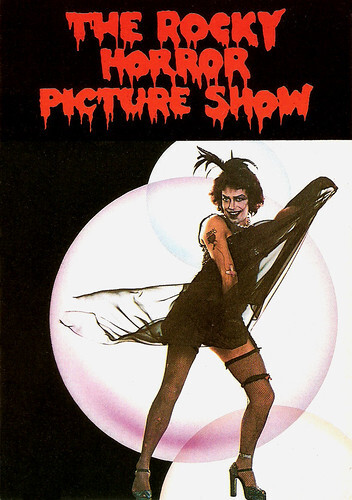
British poster postcard. Tim Curry in The Rocky Horror Picture Show (Jim Sharman, 1975).

British postcard by Film Review, set H, card 1. Photo: Walt Disney / Buena Vista (UK) International Ltd. Kiefer Sutherland, Charlie Sheen , Chris O'Donnell, Oliver Platt, Tim Curry and Rebecca De Mornay in Three Musketeers (Stephen Herek, 1993). Caption: Disney's contemporary re-telling of a classic adventure.
Sources: Wikipedia (Dutch and English) and .

West German autograph card by Bravo, 1980. Tim Curry in The Rocky Horror Picture Show (Jim Sharman, 1975).

West German autograph card by CBS, The Family of Music, to promote the LPs 'Read My Lips' and 'Fearless'.
A favourite villain through the combination of high eyebrows, plastic smile and exaggerated intonation
Timothy James Curry was born in Grappenhall, Cheshire, in 1946. Curry is the son of school secretary Patricia and Royal Navy chaplain James Curry. His parents were very religious. His elder sister, Judith, later became a concert pianist. Curry spent most of his childhood in Plymouth. Curry developed into a talented boy soprano. His father died of pneumonia in 1958, when Curry was 12 years old. The family moved to South London, where he attended boarding school before attending the prestigious Kingswood School in Bath, Somerset, England, till he was 18.
Deciding to concentrate on acting, he graduated from the University of Birmingham with a combined BA in English and drama in 1968. Curry's first full-time role was as part of the original London cast of the musical 'Hair' in 1968. There he met Richard O'Brien, who went on to write Curry's role of Dr. Frank-N-Furter in the musical 'The Rocky Horror Show' (1973). He played the character as a diabolical mad scientist and transvestite with an upper-class Belgravia accent. The show was an immediate smash hit.
The reviewer of The Guardian wrote that Curry gave a "garishly Bowiesque performance as the ambisextrous doctor." He reprised the role in Los Angeles in 1974 and on Broadway in 1975. His real breakthrough came with the film version, The Rocky Horror Picture Show (Jim Sharman, 1975). It made Curry a household name and gave him a cult following. Curry returned to the stage with Tom Stoppard's 'Travesties', which ran in London and New York from 1975 to 1976. Curry's performance as the famous dadaist Tristan Tzara received good reviews. 'Travesties' was also a Broadway hit, which won two Tony Awards.
Tim Curry began to appear in many films, including the British Horror film The Shout (Jerzy Skolimowski, 1978) starring Alan Bates . In 1978, his first album was released, 'Read My Lips'. He followed this up with 'Fearless' (1979) and 'Simplicity' (1981). After that, Curry focused entirely on his acting career. In 1980, he played Wolfgang Amadeus Mozart in the original Broadway version of 'Amadeus'. Curry was nominated for his first Tony Award (Best Performance by a Leading Actor in a Play) but lost out to his co-star Ian McKellen , who played Antonio Salieri. In 1982, Curry played the Pirate King in Gilbert and Sullivan's 'The Pirates of Penzance' opposite George Cole and Pamela Stephenson.
The combination of high eyebrows, plastic smile and exaggerated intonation in his words made Curry a favourite villain in films and series. He appeared as Johnny LaGuardia in Times Square (Allan Moyle, 1980), as Daniel Francis "Rooster" Hannigan in the film version of Annie (John Huston, 1982), and as Jeremy Hancock in the political film The Ploughman's Lunch (Richard Eyre, 1983). Director Ridley Scott cast Curry as The Lord of Darkness in the Fantasy film Legend (1985) starring Tom Cruise . The same year, Curry appeared in the Mystery comedy Clue (Jonathan Lynn, 1985) as Wadsworth the butler.

American postcard in the 20th Century Fox Series by the American Postcard Company, no. F21, 1982. Photo: Twentieth Century-Fox. Tim Curry as Dr. Frank-N-Furter (a scientist), Nell Campbell as Little Nell (a groupie), Patricia Quinn as Magenta (a domestic) and Richard O'Brien as Riff Raff (a handyman) in The Rocky Horror Picture Show (Jim Sharman, 1975).

British postcard by Pyramid, Leicester, no. PC 8300. Tim Curry, Patricia Quinn and Richard O'Brien in The Rocky Horror Picture Show (Jim Sharman, 1975).
Pennywise, the child-killing clown
In the mid-1980s, Tim Curry performed in the play 'The Rivals' and with the Royal National Theatre in 'The Threepenny Opera' and other plays. From 1987 to 1988, he toured in the lead role of Bill Snibson in the musical 'Me and My Girl'. After Clue, Curry was cast in more film comedies in the late 1980s and 1990s. He played Mr. Hector the suspicious Plaza Hotel concierge in Home Alone 2: Lost in New York (Chris Columbus, 1992) and Long John Silver in Muppet Treasure Island (Brian Henson, 1996). He also appeared in action films, such as the thriller The Hunt for Red October (John McTiernan, 1990) as Dr. Yevgeniy Petrov, The Three Musketeers (Stephen Herek, 1993) as Cardinal Richelieu, and the superhero film The Shadow (Russell Mulcahy, 1994) as Farley Claymore. In 1992, he played Alan Swann in the Broadway version of 'My Favorite Year', earning him his second Tony Award nomination (Best Performance by a Leading Actor in a Musical).
In the early 1990s, Tim Curry was one of the first well-known Hollywood actors to lend his voice to a character in a computer game. He provided the voice of the main character in parts 1 and 3 of the Gabriel Knight series. Besides Curry, Mark Hamill (best known as Luke Skywalker) and Leah Remini also lent their voices to the series. In 1991, he won a Daytime Emmy Award for his voice role as Captain Hook in the animated series Peter Pan and the Pirates (Nobuo Tomizawa, 1990-1991). He also voiced Hexxus in the film FernGully: The Last Rainforest (Bill Kroyer, 1992), King Chicken in Duckman (Jeff McGrath, a.o., 1994–1997), Sir Nigel Thornberry in The Wild Thornberrys (Cathy Malkasian, a.o., 1998–2004), and Chancellor Palpatine / Darth Sidious in Star Wars: The Clone Wars (Dave Filoni, a.o., 2012–2014).
One of Curry's best-known television roles is as Pennywise the child-killing Clown in the Horror miniseries Stephen King's It (Tommy Lee Wallace, 1990). Although Curry has appeared in numerous television series throughout his career, he has only had lead roles in two live-action series: Over the Top (Michael Lembeck, a.o., 1997) with Annie Potts, a sitcom that he also produced, and the revival series of Family Affair (Barnet Kellman, a.o., 2002–2003). Both were cancelled after one season.
In the early 2000s, Curry was cast in the film adaptation of Charlie's Angels (Mc G, 2000) in the role of Roger Corwin, and in the parody film Scary Movie 2 (Keenen Ivory Wayans, 2001) playing Professor Oldman. Curry went on to play Thurman Rice, a supporting role in the biographical film Kinsey (Bill Condon, 2004) starring Liam Neeson , and portrayed Alexander Monro in the British black comedy Burke & Hare (John Landis, 2010). In 2004, Curry began his stage role as King Arthur in 'Spamalot' in Chicago. The musical was directed by Mike Nichols, written by Monty Python member Eric Idle and based on the film Monty Python and the Holy Grail (Terry Gilliam, Terry Jones, 1975). The show successfully moved to Broadway in February 2005. and sold more than $1 million worth of tickets in its first 24 hours. His performance brought Curry a third Tony nomination, again for Best Performance by a Leading Actor in a Musical. He reprised this role in London's West End, where Spamalot opened in 2006. Curry was nominated for a Laurence Olivier Award.
In 2013, Tim Curry suffered a major stroke and lost the use of his legs. Since then, Curry uses a wheelchair and shifted his work mostly to voice acting, although he has continued to perform as a singer and make appearances at fan conventions. He played the Criminologist in the TV film The Rocky Horror Picture Show: Let's Do the Time Warp Again (Kenny Ortega, 2016) starring Laverne Cox. In 2024, he had a cameo appearance in the Horror film Stream (Michael Leasy, 2024), providing the voice of the mask character Lockwood. Curry is working on a memoir titled 'Vagabond', scheduled to be released on 7 October 2025. Curry has never discussed his private life in interviews.

Vintage postcard by Palm Pictures, no. C 12. Tim Curry, Patricia Quinn and Nell Campbell in The Rocky Horror Picture Show (Jim Sharman, 1975). Caption: Micro.

British poster postcard. Tim Curry in The Rocky Horror Picture Show (Jim Sharman, 1975).

British postcard by Film Review, set H, card 1. Photo: Walt Disney / Buena Vista (UK) International Ltd. Kiefer Sutherland, Charlie Sheen , Chris O'Donnell, Oliver Platt, Tim Curry and Rebecca De Mornay in Three Musketeers (Stephen Herek, 1993). Caption: Disney's contemporary re-telling of a classic adventure.
Sources: Wikipedia (Dutch and English) and .
Published on July 22, 2025 22:00
Paul van Yperen's Blog
- Paul van Yperen's profile
- 13 followers
Paul van Yperen isn't a Goodreads Author
(yet),
but they
do have a blog,
so here are some recent posts imported from
their feed.



